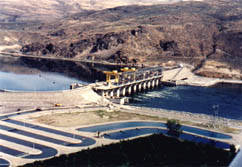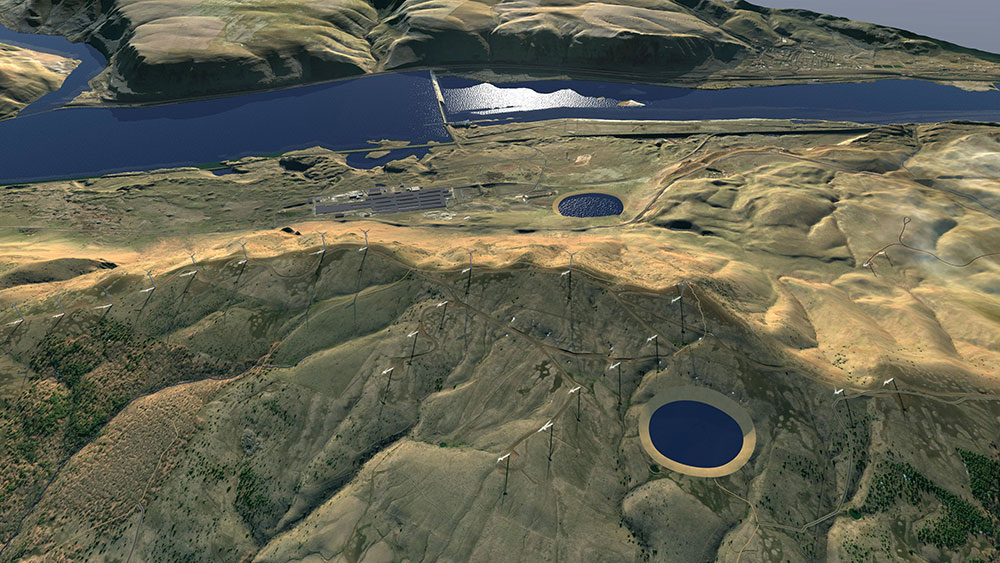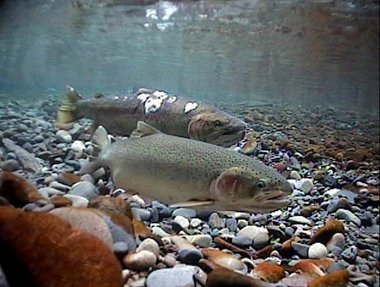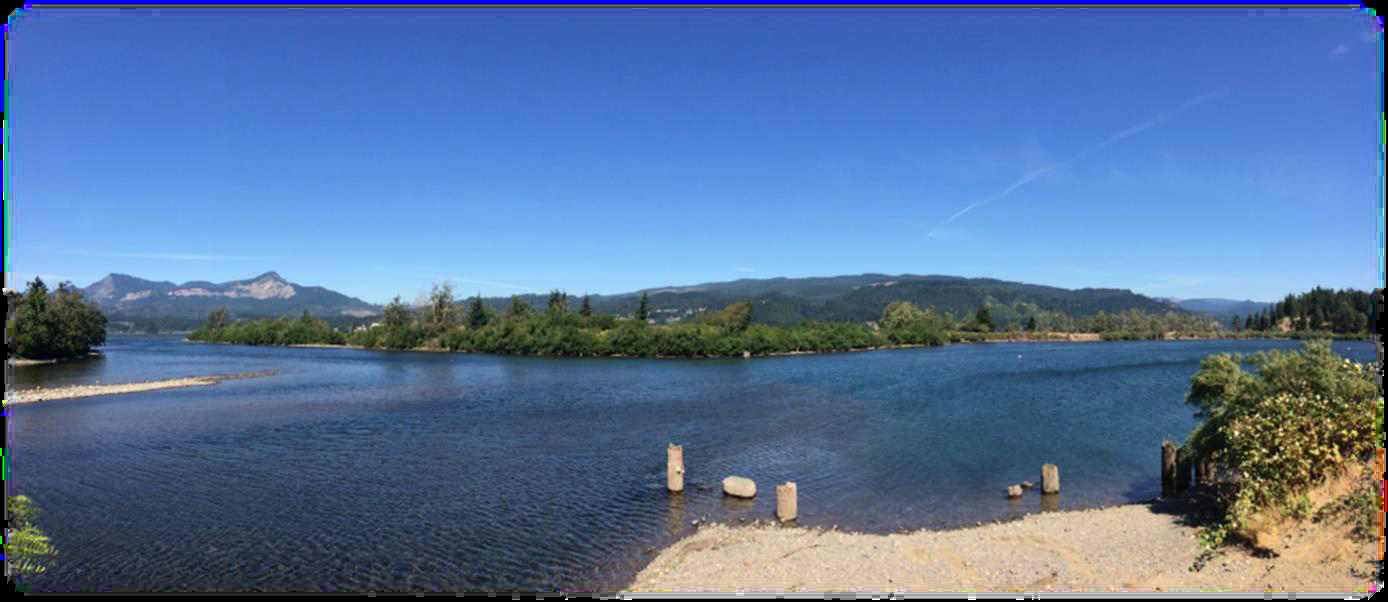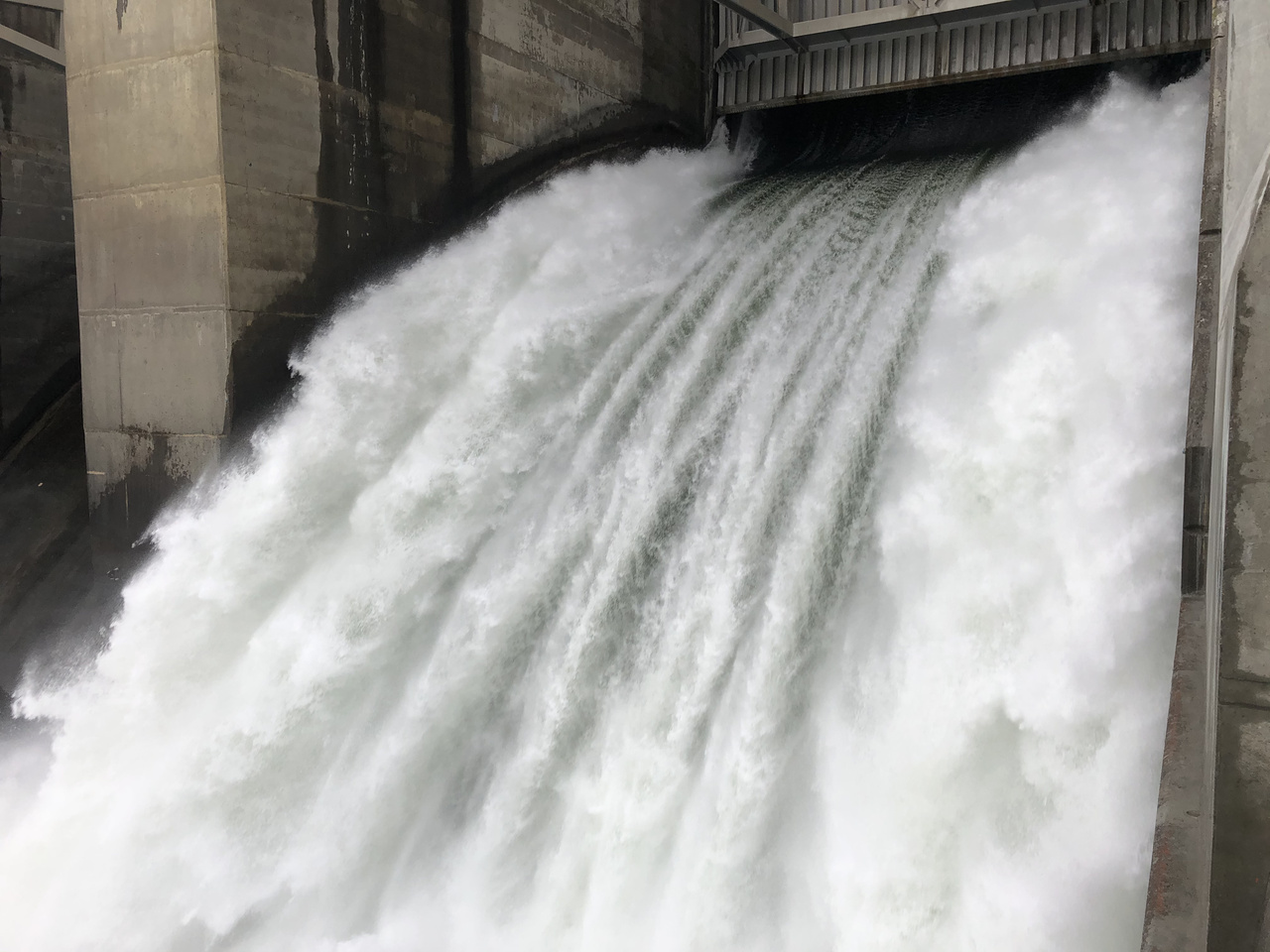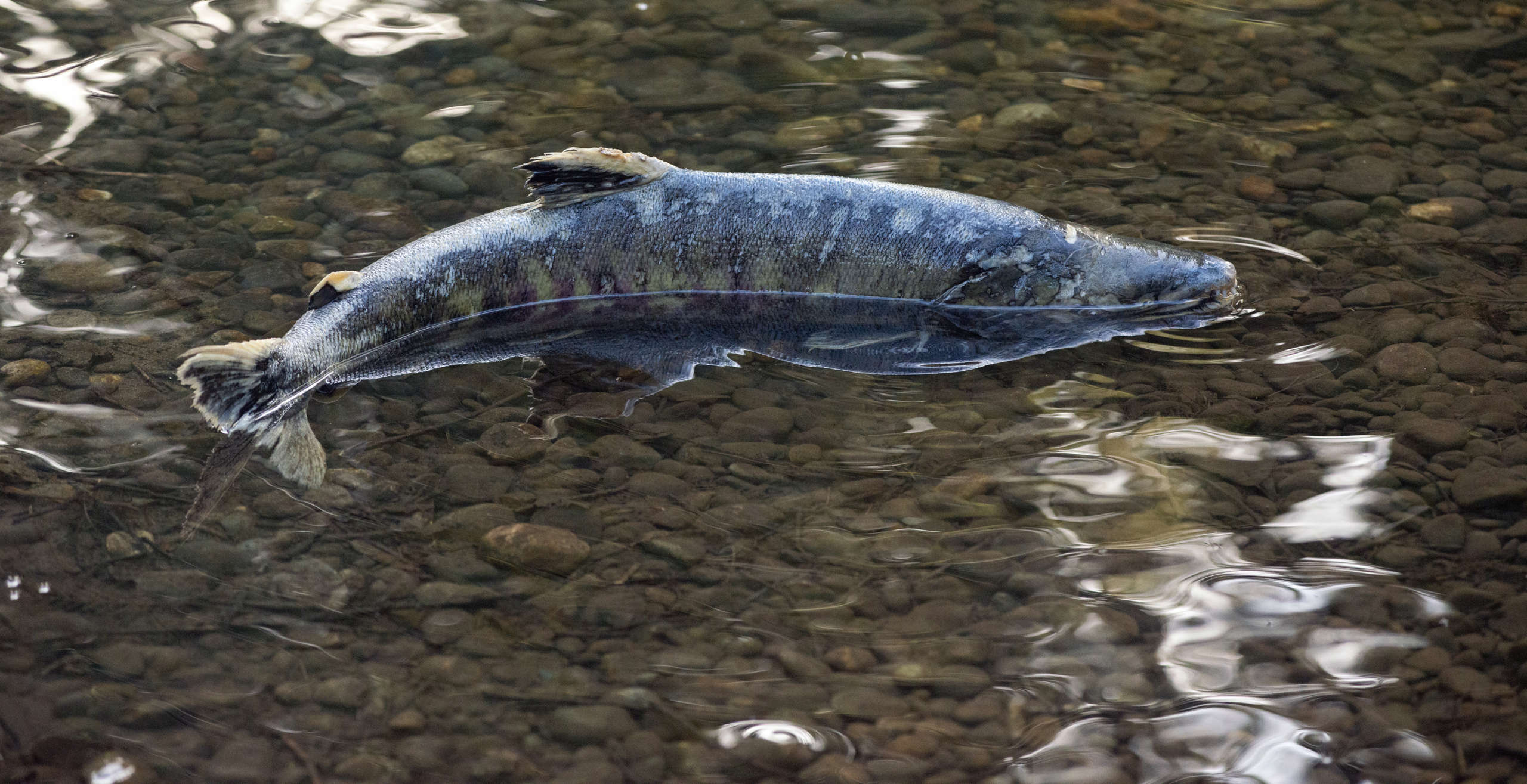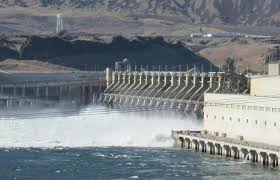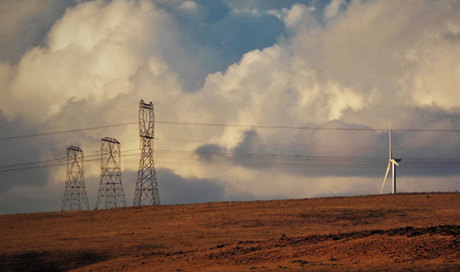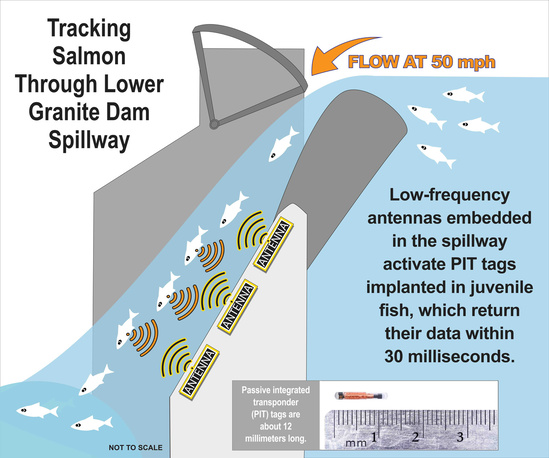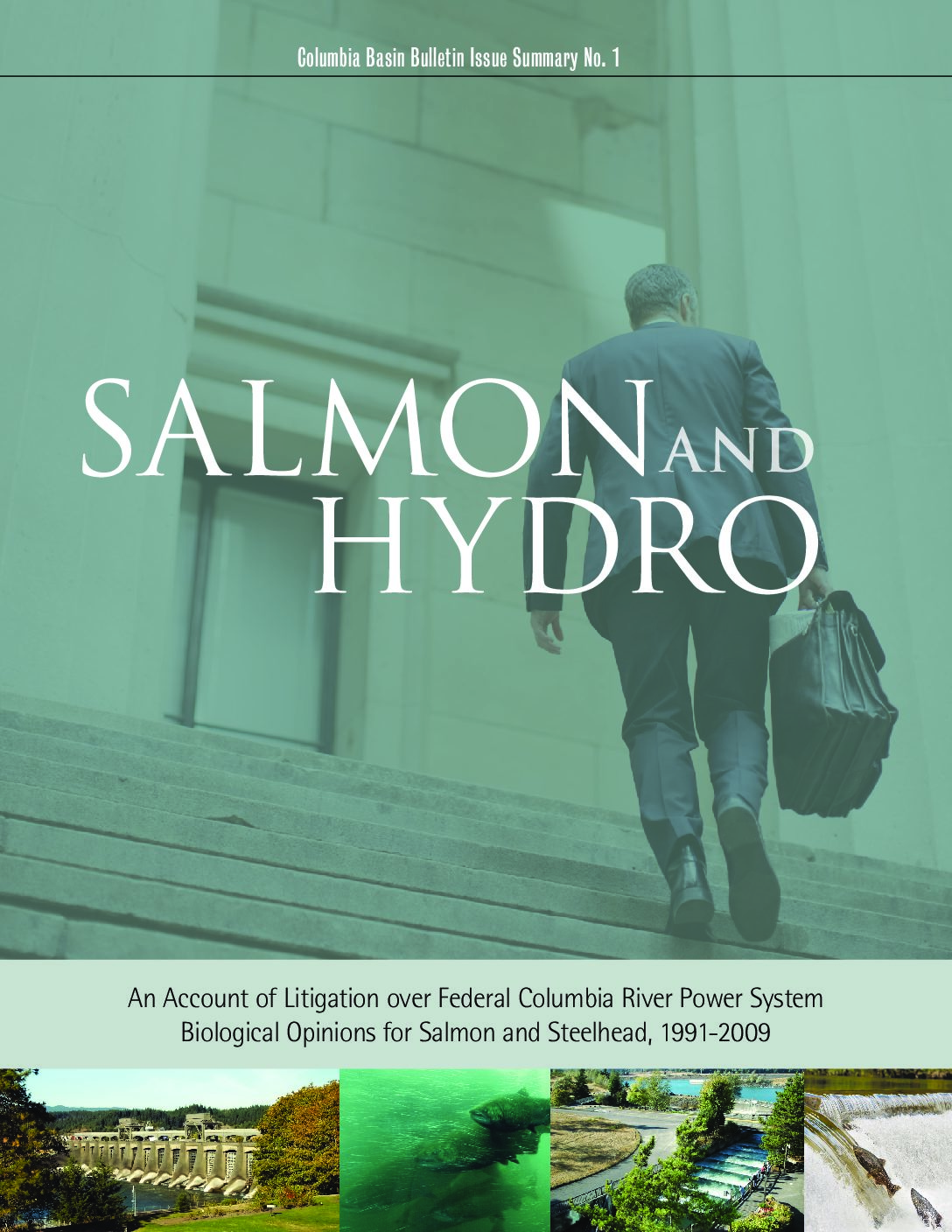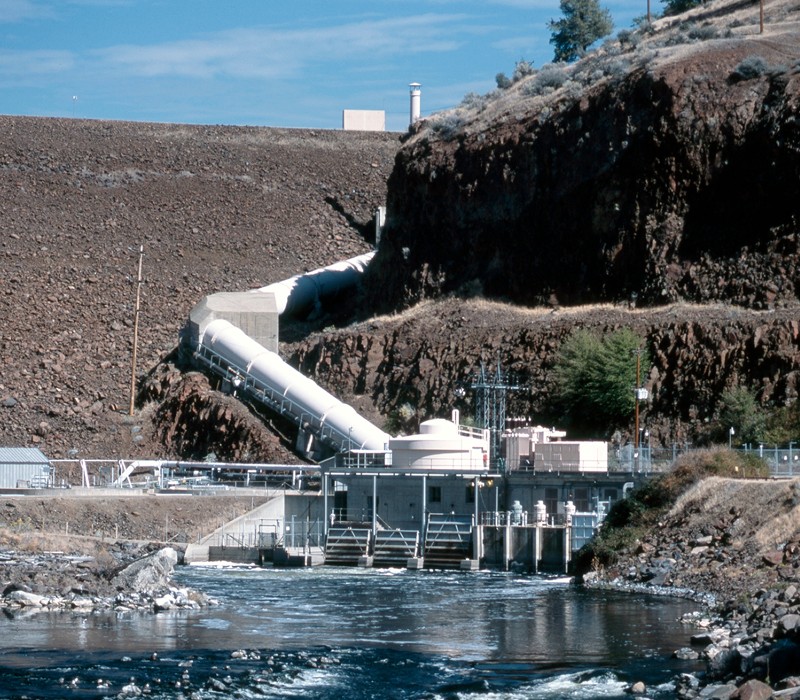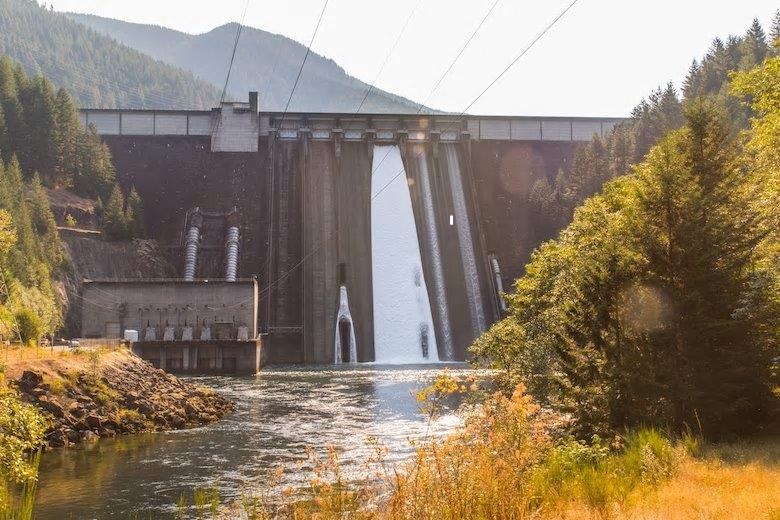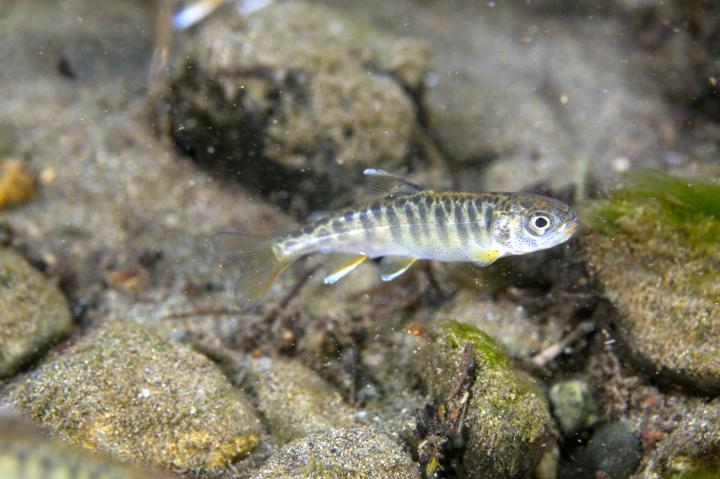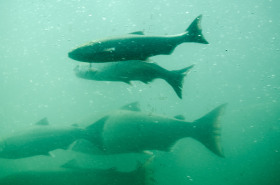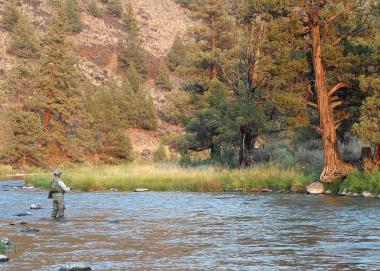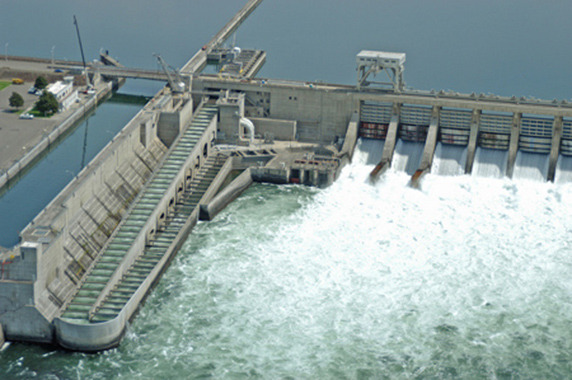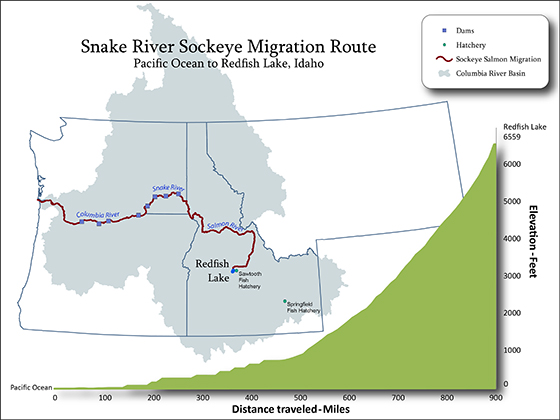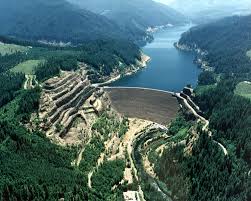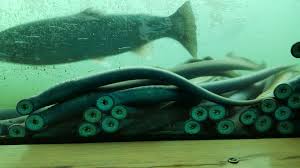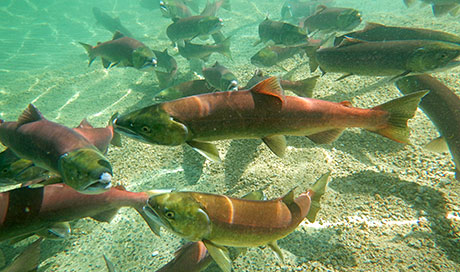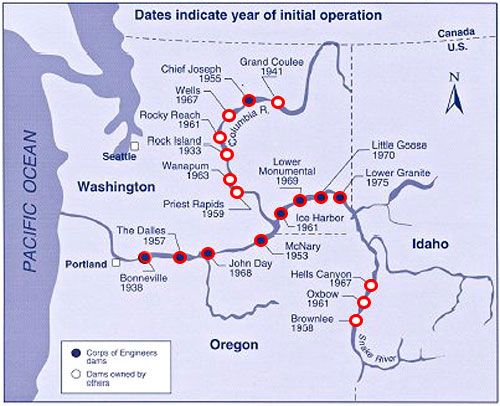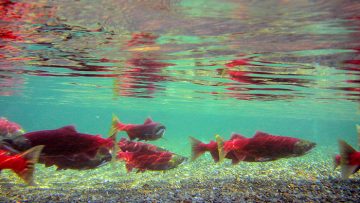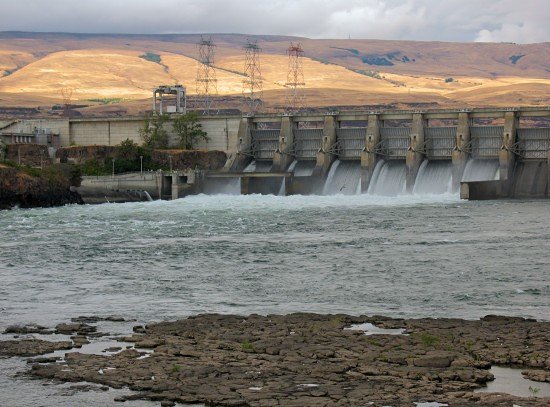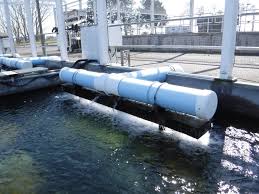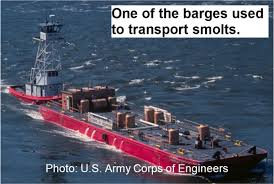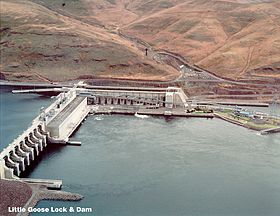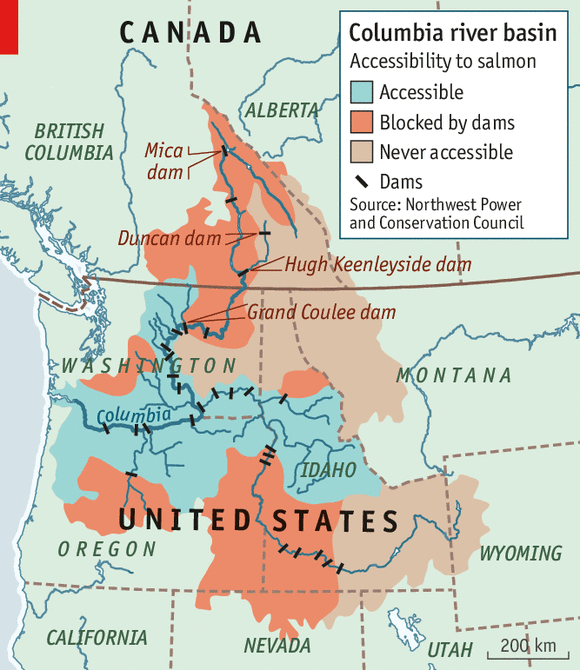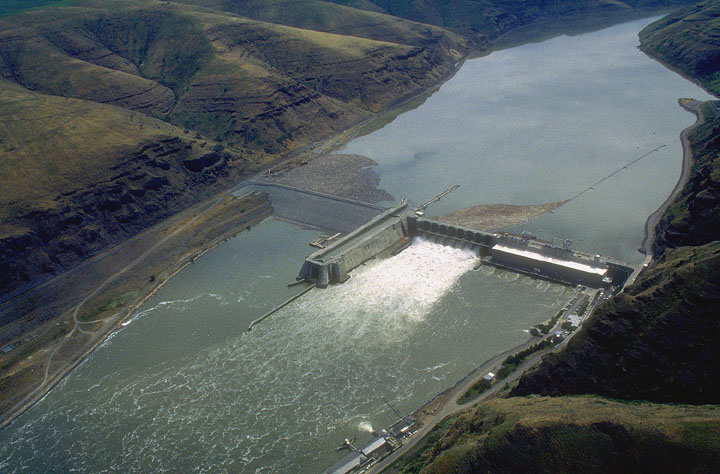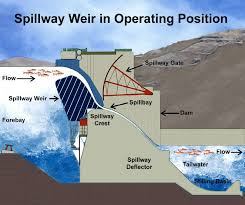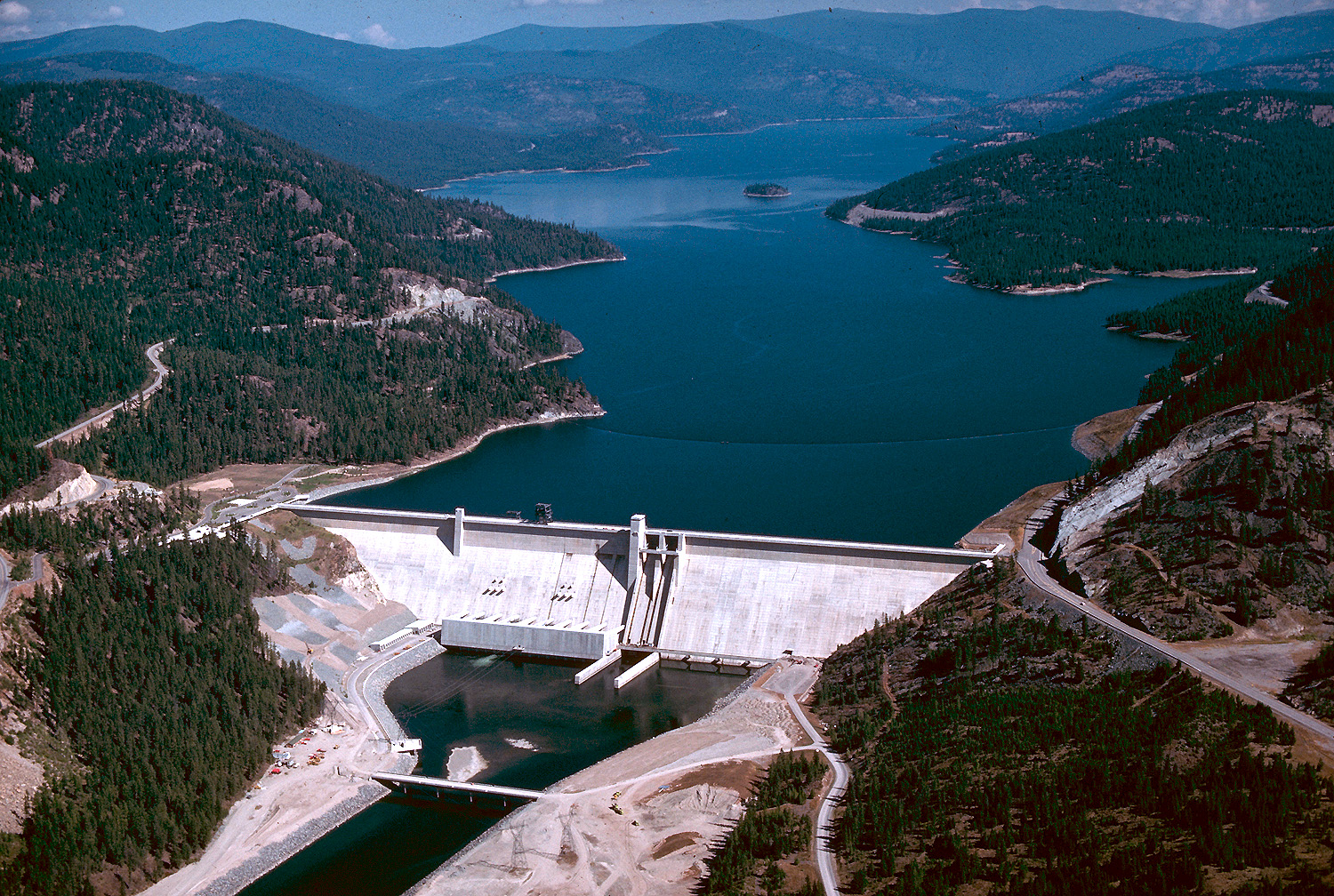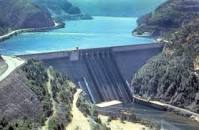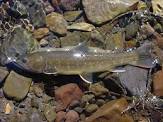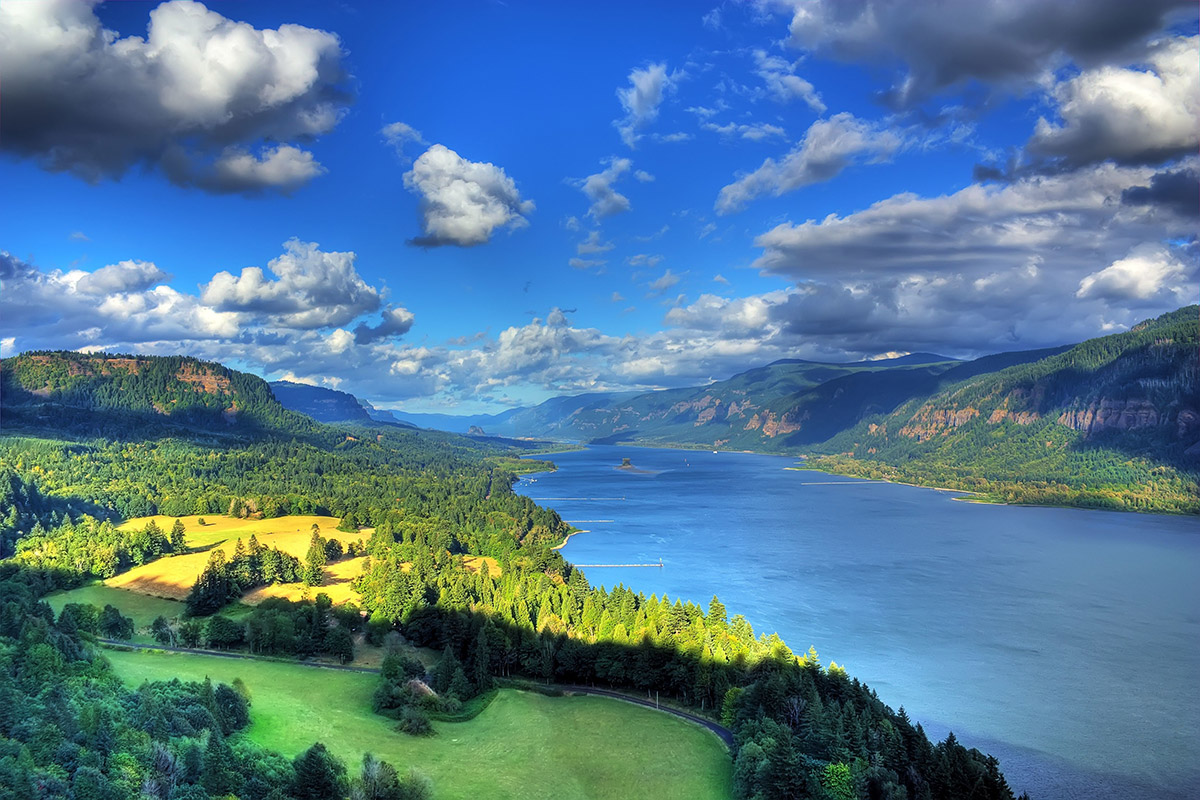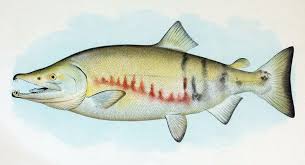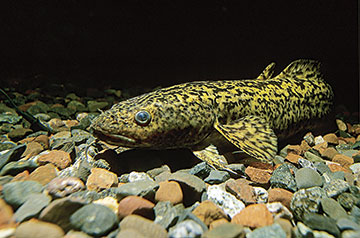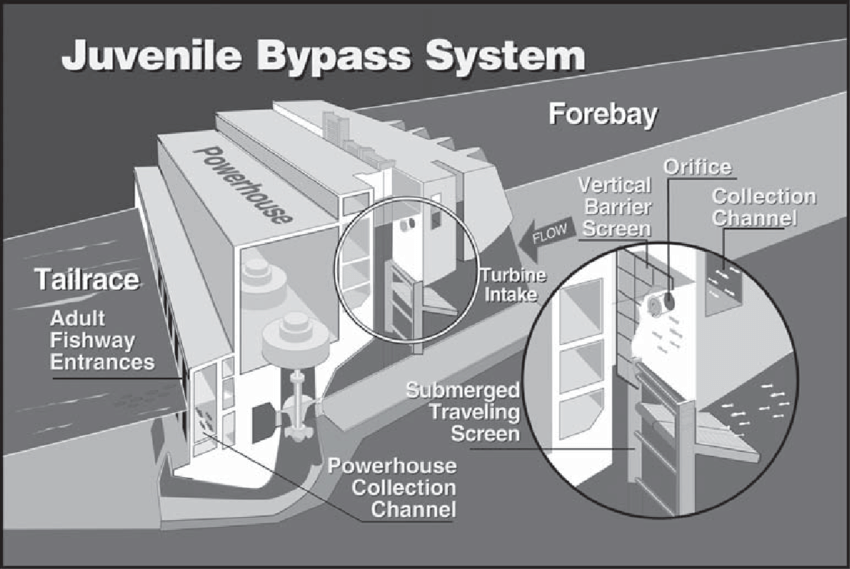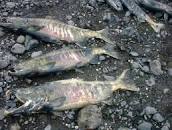Mid-Columbia PUDs Explain How They Manage Five Dams, Reservoirs To ‘No-Net-Impact’ Survival Standard For Salmon, Steelhead
February 12th, 2021
Five dams and reservoirs on the Columbia River in Washington State between McNary Dam and Chief Joseph Dam are being managed under a unique “No Net Impact” survival standard for salmon and steelhead.
Idaho U.S. Rep. Simpson Proposing Sweeping $32 Billion ‘Columbia Basin Fund’ To Finance Lower Snake River Dam Breaching
February 5th, 2021
Idaho Republican U.S. Rep. Mike Simpson has been discussing with regional parties a $32 billion “Columbia Basin Fund” to finance the breaching of the lower Snake River dams, new energy technologies to replace the lost hydropower, and compensation to communities and businesses that depend on the dams.
Fisheries Managers Object To Fluctuating ‘Load Following’ Releases Out Of Dworshak; Says Harms Fish, Fishing, River
February 5th, 2021
Fisheries managers are not happy about federal hydro managers’ decision to engage in “day load shaping operations” at Idaho’s Dworshak Dam last week, a practice that has not been implemented since 1986. The biologists say such operations negatively impact juvenile fall chinook, fisheries and river ecology.
GUEST COLUMN: Reflections, Perspectives On Idaho Salmon Workgroup Recommendations
January 29th, 2021
The robust fishery science literature— beginning with the “Plan for Analyzing and Testing Hypothesis” (Marmorek et al.1998) in the 1990s and continuing to the 2020 report “Achieving Productivity to Recover and Restore Columbia River Stream-type Chinook Salmon (Petrosky et al. 2020)—documents the necessity to achieve an average 4% smolt-to-adult return (SAR) survival in order to recover Snake River (Idaho) salmon and steelhead.
Washington State Salmon Recovery Report: Most Populations Not Making Progress, Some On Path To Extinction
January 15th, 2021
A new report from Washington State’s Governor’s Salmon Recovery Office shows that most salmon populations in the state still are not making progress and some are teetering on the brink of extinction.
WDOE Wants Public Comment On Proposed New Hydropower Project On Columbia River: Closed Loop Pumped Storage
January 15th, 2021
The Washington Department of Ecology is seeking comment on what should be considered when preparing an environmental impact statement for a new hydropower project proposed along the Columbia River in Klickitat County.
Idaho’s ‘Salmon Workgroup’ Submits Policy Recommendations To Governor; No Consensus On Dam-Breaching
January 8th, 2021
The state of Idaho’s “Salmon Workgroup” last week released a final report that includes policy recommendations for Gov. Brad Little to consider that aim “to restore abundant, sustainable, and well distributed populations of salmon and steelhead in Idaho for present and future generations, while recognizing diverse interests throughout the State.”
EPA Releases Final ‘Cold Water Refuges Plan’ Identifying Cooler Water Zones In Lower Columbia That Give Salmonids Relief From High Temps
January 8th, 2021
The U.S. Environmental Protection Agency’s northwest regional office this week released the Columbia River Cold Water Refuges Plan, identifying zones of cooler water important to adult salmon moving upstream, particularly steelhead and fall chinook. However, EPA says fish that use refuges do not have higher survival rates to upstream waters “primarily due to fishing in the refuges.”
Columbia River Treaty Update: Conroy Returns As B.C. Minister Responsible For Treaty, PNW Reps. Introduce Termination Notice Resolution
December 31st, 2020
Following last month’s British Columbia general election, Premier John Horgan announced the new provincial Cabinet, naming Katrine Conroy as B.C.’s first female Minister of Forests, Lands, Natural Resource Operations and Rural Development. She will also return to her role as Minister Responsible for the Columbia Basin Trust, Columbia Power Corporation and the Columbia River Treaty.
Fisheries/Hydro Managers Give High Grades To 2020 Flexible Spill Operations; Aided Juvenile Salmonids, Netted BPA $4.7 Million
December 18th, 2020
The states of Oregon and Washington, the Nez Perce Tribe, the Bonneville Power Administration and the U.S. Army Corps of Engineers told the Northwest Power and Conservation Council this week that flexible spill in 2020 met all of a flexible spill agreement’s goals in its second year. All were signatories to the 2018 flexible spill agreement.
Annual Flow Operations To Protect ESA-Listed Chum Salmon Underway; Last Salmon To Return, First To Leave
December 17th, 2020
River operators are holding the Columbia River downstream of Bonneville Dam to 11.5 to 13 feet above sea level, a tailwater depth at the dam designed to ensure chum salmon can spawn and that their redds (nests) will remain underwater near Ives and Pierce islands.
EDITOR’S NOTEBOOK: 40 Years Ago (Dec. 5, 1980) Northwest Power Act Gave NW Governors A Unique, Strong Tool For Regional Collaboration To Protect, Mitigate, Enhance Fish Runs
December 17th, 2020
If John Dingell didn't like animals would any sort of fish protection have been included in the 1980 Northwest Power Act signed this month 40 years ago?
Oregon Files Intent To Challenge Feds’ New EIS/BiOp For Basin Salmon/Steelhead In Case Regional Collaboration Goes Nowhere
December 11th, 2020
While stressing its commitment to regional collaboration, the state of Oregon at the same time has announced its intent to sue the federal government over the new environment impact statement and biological opinion for Columbia River salmon and steelhead, alleging violations of the Endangered Species Act. The state says it is preserving “legal options” in case collaboration falls short.
In Appeal To Ninth Circuit To Overturn Water Quality Ruling, Deschutes River Alliance Says Adaptive Management Not Working
December 11th, 2020
In asking the Ninth Circuit Court of Appeals to overturn a 2018 U.S. District Court ruling that Portland General Electric had not committed water quality violations at its Pelton Round Butte Project on the Deschutes River, the Deschutes River Alliance asserts that adaptive management has not been effective when it comes to maintaining state water quality standards in the river.
BPA Releases FY 2022-23 Rates, Tariff Changes, Proposed Debt Reduction Measures To Assist In Future Cost Containment
December 11th, 2020
In releasing its proposal for Fiscal Year 2022-2023 rates and tariff changes, the Bonneville Power Administration says it “is maintaining its commitment to keeping its wholesale rates as low as possible consistent with sound business principles, striking a balance between cost containment, long-term financial health and spending to meet the needs of its customers.”
2020 River Operations In Review: Flexible Spill Data Shows Faster Travel Times For Juvenile Salmonids, Less Collisions With Turbines
December 3rd, 2020
In its second year, which was an average flow year, the higher flexible spill operations yielded faster travel time for juvenile salmon and steelhead, fewer collisions by juveniles with turbines and better overall survival through Snake River dams, all while the Bonneville Power Administration actually made some money.
GUEST COLUMN: (RESPONSE) IT SHOULDN’T TAKE A DEGREE IN MARINE BIOLOGY TO SEE THE OBVIOUS
November 30th, 2020
By David Welch
Mr. Hawley misconstrues my shock—I am shocked because biologists monitoring survival thought it unimportant to ask why salmon survival reported elsewhere was no better than Snake River populations. Decades ago someone should have asked what was wrong with the accumulating data (and fixed it) or asked why current Columbia Basin policy laser-focused on the dams can really restore salmon populations if survival is the same elsewhere. The answer reported in our paper is that the data really are consistent with a coastwide decline but that the Columbia also has a big problem with what was thought to be the gold standard in survival monitoring—PIT tag data. This too is shocking.
Salmon and Hydro: An Account Of Litigation 1991-2009
November 24th, 2020
In 2009, the Columbia Basin Bulletin produced the 77-page e-book “SALMON AND HYDRO: An Account of Litigation over Federal Columbia River Power System Biological Opinions for Salmon and Steelhead, 1991-2009.” We are making the book available to CBB members.
States, Tribes, PacifiCorp Sign MOA To Resolve FERC Concerns, Keep Klamath Dams’ Removal Alive (Largest Dam Removal In US History)
November 20th, 2020
The states of Oregon and California, the Yurok Tribe, the Karuk Tribe, PacifiCorp and the Klamath River Renewal Corporation signed a memorandum of agreement this week that describes how the parties will implement the amended Klamath Hydroelectric Settlement Agreement as negotiated and signed in 2016. The KHSA sets the terms for the removal of four Klamath River dams.
Despite Covid, Wildfires, Bonneville Power FY 2020 Far Exceeded Expected Net Revenues Due To Lower Expenses, Secondary Sales During Heat Waves
November 20th, 2020
The Bonneville Power Administration’s fiscal year 2020 annual report says the agency exceeded projected net revenues by $233 million.
GUEST COLUMN: It Doesn’t Take A Degree In Marine Biology To See Dams Are Bad For Fish
November 20th, 2020
Last July, National Geographic reported that global populations of migratory fish have declined by 76 percent over the past half-century. Habitat loss was cited as one of the main culprits, and dams as a major cause of habitat loss. This type of cause and effect in worldwide decline holds true in the Pacific Northwest. It doesn’t take a degree in marine biology to see that dams are bad for fish. But it might take someone with a PhD to convince you that salmon don’t need rivers.
Study Shows All West Coast Chinook In Decline Whether River Dammed, Undammed; Cites Ocean Conditions As Key Cause
November 12th, 2020
A recent study shows that all stocks of chinook salmon are declining along the West Coast at about the same rate and concludes that habitat and dams are not the likely culprits. It’s something far more out of our control: The ocean.
Missing Data: Covid, High Spill, Low Fish Detection Results In Lack Of 2020 Juvenile Salmonid Survival Estimates From Upstream Dams To Below Bonneville
November 12th, 2020
Every year about this time, NOAA Fisheries releases a memo detailing preliminary survival estimates for passage of spring-migrating juvenile salmonids through Snake and Columbia River dams – key data for assessing the impact of federal hydropower operations on 13 species of salmon and steelhead listed under the Endangered Species Act. This year, however, due to Covid-19 impacts and more spill for fish, that data took a hit.
Corps Modifies Operations At Willamette Valley Dam To Improve Juvenile Salmon Passage As Court Case Continues On ‘Remedies’ For Wild Salmon/Steelhead
November 12th, 2020
The U.S. Army Corps of Engineers is modifying operations at the Willamette Valley’s Detroit Dam to improve juvenile salmon downstream passage survival by releasing water exclusively through the upper regulating outlets when downstream passage rates are high.
Science Panel Would Like To See Fish Passage Center’s Annual Salmon Survival Report Include ‘Impact Report’ Communicating Key Messages
November 12th, 2020
The Fish Passage Center’s annual Comparative Survival Study, providing smolt-to-adult return data and analysis for Columbia/Snake River salmon and steelhead for 25 years, should include an “impact report” to communicate “the most critical take-home messages” for policymakers.
Columbia Basin Partnership Releases Final Report Stressing Urgency In Addressing Salmon, Steelhead Recovery
October 30th, 2020
The Columbia Basin Partnership Task Force released late this afternoon its final report saying there is “a strong sense of urgency that immediate action is needed to address salmon and steelhead declines in the Columbia River Basin.”
Wild Upper Columbia Spring Chinook Long Way From Recovery, Less Than 1 Percent Return To Spawning Grounds
October 30th, 2020
Wild Upper Columbia spring chinook are “pretty far from de-listing,” said Dan Rawding, Columbia River Salmon Recovery Coordinator for the Washington Department of Fish and Wildlife, in a presentation at this month’s Northwest Power and Conservation Council meeting.
NW States Agree To ‘Define A Future Collaborative Framework’ For Achieving Abundance Goals For Columbia Basin Salmon/Steelhead
October 15th, 2020
In a letter Friday (Oct.9) the four Northwest states announced they have agreed to work together to rebuild Columbia River salmon and steelhead stocks and to advance the goals of the Columbia Basin Partnership Task Force.
Oregon Commission Denies Fish Passage Waiver For Crooked River’s Bowman Dam; Proposed Mitigation Not Enough For Steelhead, Salmon, Trout
October 15th, 2020
The Oregon Fish and Wildlife Commission voted Oct. 9 to deny a fish passage waiver for the Crooked River’s Bowman Dam in a split 5-1 vote, after hearing testimony from 28 people for and against the project. At issue is the passage of native migratory fish, such as summer steelhead, chinook salmon and redband trout.
Agencies Issue Record Of Decision On Plan To Operate 14 Columbia/Snake Dams Without Jeopardizing Salmon,Steelhead; Critics Say More Status Quo
October 1st, 2020
The U.S. Army Corps of Engineers, Bureau of Reclamation and Bonneville Power Administration signed a joint Record of Decision on Monday that commits the agencies to implementing immediate and long-term actions identified in July in a final environmental impact statement for operations of 14 Columbia/Snake River mainstem dams. The Columbia River Systems Operations EIS also includes a new biological opinion for 13 species of salmon and steelhead listed under the Endangered Species Act.
Hydro Managers Reject Salmon Managers Request To Push Back Start Date On Zero Nighttime Generation In Lower Snake; Decision Elevated To Oversight Group
October 1st, 2020
Dam operators this week said they would not delay the start date for zero nighttime generation in the Snake River, despite the continued presence of migrating adult salmon and steelhead in the river. That forced fishery managers at the interagency Technical Management Team meeting, Wednesday, Sept. 30, to elevate the request to a policy-level group known as the Regional Implementation Oversight Group.
Fishery Managers Want Changes In Fall Lower Snake Flow Operations Outlined In New 2020 Salmon/Steelhead BiOp, Say Impacts ESA Fish Still Migrating
September 24th, 2020
Fishery managers this week asked dam operators to postpone zero nighttime flow operations at lower Snake River dams, effectively asking them to set aside an operation included in NOAA Fisheries’ 2020 biological opinion of the impacts on salmon and steelhead of the Columbia/Snake river power system and the Columbia River System Operator’s environmental impact statement even before the CRSO completes its record of decision.
EPA’s TMDL Document Aimed At Keeping Water Temps Healthy For Columbia/Snake Salmon Draws Far-Ranging Comments, Criticisms
September 18th, 2020
Most of those who commented on the Environmental Protection Agency’s “Total Maximum Daily Load” document intended to set temperature limits in the Columbia and Snake Rivers to protect salmon and steelhead called for further changes to the TMDL.
Snake River Sockeye Nears End Of Run At 68 Percent Of Average, Fall Chinook Passage Gaining Steam; Cool Down In Lower Snake
August 27th, 2020
With just one to two endangered Snake River sockeye salmon passing Lower Granite Dam daily, the end of the run seems nearly complete.
Federal Judge Rules Corps Not Moving Fast Enough To Halt Continued Decline Of ESA-Listed Upper Willamette River Wild Spring Chinook/Steelhead; “Significant Measures Never Carried Out’
August 19th, 2020
A U.S. District Court ruling this week charged a federal agency with not moving fast enough to ensure survival and recovery of Upper Willamette River wild spring chinook and wild winter steelhead, two species listed as threatened in 1999 under the federal Endangered Species Act.
For Second Time, Columbia/Snake River Fisheries Managers Reject Raising Lower Granite Pool To Aid Grain Shipments
August 19th, 2020
For the second consecutive week, fisheries managers at the multi-agency Technical Management Team denied the Port of Clarkston a request to raise the Lower Granite Dam reservoir one and a half feet above the normal minimum operating pool (MOP +2) to provide more depth for barges loading grain at the port’s docks.
Lamprey Fish Passage Efficiency At Each Columbia/Snake Dam Very Low: Nearly Half Lost (Not Counted) At Each Dam From Bonneville Dam To McNary
August 14th, 2020
A variety of changes at Columbia and Snake river dams to boost passage of Pacific lamprey is resulting in incremental improvements, according to a presentation this week at a Northwest Power and Conservation Council meeting.
River Managers Reject Request To Raise Lower Granite Pool To Aid Barge Loading At Clarkston Port; Concerns About Temperature Impacts To Salmon
August 13th, 2020
With wheat harvest in full swing, the Lewis-Clark Terminal on the lower Snake River at the Port of Clarkston is having difficulties loading barges due to shallow water as the result of sediment buildup at the facilities. On Wednesday, the port requested that river operators raise the Lower Granite Dam reservoir up to a foot-and-a- half more to provide some more wiggle room for loading.
New Federal EIS, BiOp For Columbia/Snake Hydro System Distinct From Recovery Plans; Broader Regional Actions Needed To De-List Salmon, Steelhead
August 6th, 2020
Tucked into the Columbia River System Operators’ final environmental impact statement for the Columbia River power system’s impacts on salmon and steelhead that was released late last week is a more than 1,600 page biological opinion from NOAA Fisheries.
Endangered Snake River Sockeye Arriving At Idaho’s Sawtooth Basin, Numbers Better Than Last Year’s Dismal Return
August 6th, 2020
The first two sockeye salmon completed their 900 mile journey through eight Columbia and Snake river dams and up the Salmon River, climbing 6,500 feet in elevation and arriving in Idaho’s Sawtooth Basin over the weekend.
Modernizing Columbia River Treaty: B.C. Report On Community Meetings Says This Time Basin Residents, Indigenous Nations Will Be ‘Meaningfully Consulted’
August 6th, 2020
A British Columbia Province Report on recent Columbia River Treaty community meetings notes “there was a lack of consultation with Basin residents and Indigenous Nations when the Treaty was first negotiated, and feelings of hurt and anger remain to this day.”
Federal Agencies Release Final EIS For Columbia/Snake River Dams, Includes Biological Opinion For Salmon, Steelhead (Regional Reaction Swift)
July 31st, 2020
The U.S. Army Corps of Engineers, Bureau of Reclamation and Bonneville Power Administration released this morning the final environmental impact statement for the Columbia River System Operations that includes as an appendix a new biological opinion for salmon and steelhead.
NOAA’s Life-Cycle Models For Columbia/Snake Rivers’ Salmon/Steelhead Key Component Of Final EIS/BiOp
July 31st, 2020
Biological opinions of the federal hydroelectric system’s impacts in the Columbia and Snake rivers on salmon and steelhead and the final 2020 Columbia River System Operations environmental impact statement released this morning, have benefited from NOAA Fisheries’ life-cycle modeling.
Corps Appeals Washington’s Columbia/Snake Water Temperature Requirements; Conservation Groups Seek To Intervene
July 30th, 2020
The Northwest Sportfishing Industry Association, Natural Resources Defense Council, and Columbia Riverkeeper have moved to intervene in the Army Corps of Engineers’ appeal of Washington State’s Clean Water Act certifications requiring temperature limits for Columbia and lower Snake River dams and reservoirs to protect salmon and steelhead.
Decades-Old Snake River Hatcheries Underfunded For Infrastructure Needs; Produce 20 Million Juvenile Salmon/Steelhead Each Year
July 16th, 2020
A five-year plan for non-recurring maintenance needs and infrastructure fixes at aging 35-to-40-year-old Snake River hatcheries shows a budget that is $5 million short, raising the question of who pays, according to managers and operators at the hatcheries who laid out their funding needs at the Northwest Power and Conservation Council’s Fish and Wildlife Committee meeting Tuesday, July 14.
With Flow Agreements Protecting Salmon Lifecycle, Hanford Reach Fall Chinook Productivity Over The Years Has Increased 217 Percent
July 16th, 2020
Although the 50-mile long Hanford Reach has long been considered the last free-flowing stretch on the Columbia River above Bonneville Dam, it’s actually tucked into a large and very complex system of hydroelectric dams.
Using Adaptive Management, River Managers Change Date/Method For Transporting Juvenile Salmon/Steelhead In Snake River
July 16th, 2020
Summer transportation of juvenile salmon and steelhead out of the Snake River will resume sooner than planned, according to action taken this week, Wednesday, July 15, at the interagency Technical Management Team.
Public Comments Favor Fish Passage At Crooked River’s Bowman Dam (Central Oregon) Or Increased Downstream Mitigation
July 9th, 2020
Public comment that closed June 22 for the most part favored providing anadromous fish passage at Bowman Dam on the Crooked River in Central Oregon. But if passage is not possible due to the costs, then other comments asked for far more habitat mitigation in the river downstream than was proposed the dam’s operator Ochoco Irrigation District.
With Temperatures Heating Up, Cold Dworshak Dam Water Released To Aid Low Numbers Of Endangered Snake River Sockeye Headed For Idaho
July 9th, 2020
Using cold water from Dworshak Dam, the U.S. Army Corps of Engineers began this week sending water downstream to cool the tailwater at Lower Granite Dam as an aid to sockeye salmon passage at the dam.
What Happens To Power Grid During Drought, Less Hydro? California Study Looks At Financial, Economic, Environmental Impacts
June 25th, 2020
Drought can mean restrictions for watering the lawn, crop losses for farmers and an increased risk of wildfires. But it can also hit you and your power company in the wallet.
Though Drought Conditions Persist, Columbia Basin Water Supply Forecast (Dalles Dam Flows) Stands At 107 Percent Of Normal, April-September
June 12th, 2020
Even with heavy May rainfall, most of the Columbia River basin, including the Willamette River basin, is predicted to be at some level of drought – abnormally dry to severe – in the coming months, according to the U.S. Drought Monitor.
With Enough Spring Chinook In Lower Snake Now Passing Little Goose Dam, Idaho Rescinds Spill Change Request
June 12th, 2020
Spring operations at Little Goose Dam on the lower Snake River this last weekend apparently resulted in enough spring chinook passing the dam that Idaho on Monday (June 8) rescinded a request made last week, along with NOAA Fisheries and the Nez Perce Tribe, at the interagency Technical Management Team meeting.
Spill For Juvenile Fish Migration At Lower Snake Dams Holding Back Adult Spawners Headed For Idaho; River Managers Discuss Possible Operations Change
June 5th, 2020
A proposal aimed at reducing travel time and passing more adult spring chinook salmon on the lower Snake River at Little Goose Dam was “elevated” to a higher task force for a decision this week at the interagency Technical Management Team meeting Wednesday, June 3.
Columbia River Treaty Update: Ninth Round Of Talks Completed, Exchanges ‘More Focused, Comprehensive’
May 29th, 2020
On March 11 and 12, 2020, the week before COVID-19 international travel restrictions were put into place, Canadian and American negotiators reconvened in Washington, D.C. to continue discussions about a modernized Columbia River Treaty. This was the ninth round of talks since negotiations started in May 2018.
EPA Releases Temperature Limit Study (TMDL) For Columbia/Snake River; Linked To State Water Quality Permits For Mainstem Dams
May 21st, 2020
After a 20-year wait and a lawsuit that was finally decided in the Ninth Circuit Court of Appeals, a study to determine temperature limits in the Columbia and Snake rivers for the protection of salmon and steelhead was released this week by the Environmental Protection Agency.
Columbia/Snake White Sturgeon: From Bonneville Dam To The Snake River Each Reservoir Has Own Issues
May 14th, 2020
Fisheries managers say the health of white sturgeon populations in the Columbia River is healthy, but there is a paucity of detailed abundance data from the Snake River, and that each zone – lower Columbia, Bonneville Dam to McNary Dam and the Snake River –has its own issues.
Corps Coming To End Of Fish-Friendly Construction Improvements At Columbia/Snake Dams, Moving To Operations, Maintenance
May 14th, 2020
Over the past five years, the U.S. Army Corps of Engineers has been working on a number of structural upgrades at Lower Snake and Columbia river dams, all designed to make passage at the dams safer for salmon and steelhead. Those projects are nearly finished – the last will be new fish friendly turbines at McNary Dam in 2025 followed by new turbines at John Day Dam – and the Corps now plans to concentrate on operational improvements at the dams, while ending the more expensive construction.
Libby Dam Flows Set To Increase To Encourage Spawning Of Kootenai River White Sturgeon
May 14th, 2020
Flows from Libby Dam in Montana designed to encourage white sturgeon movement and spawning in the Kootenai River will likely begin May 21, depending on water supply.
WDOE Issues Water Quality Certifications For Columbia/Snake River Dams With Conditions Requiring Water Temperatures Be Addressed
May 8th, 2020
The Washington Department of Ecology has issued final water quality certifications for the eight federal dams on the lower Columbia and lower Snake rivers, with conditions requiring federal agencies to address high water temperatures impacting salmon and steelhead.
New Antennas Embedded In Lower Granite Dam Spillway Track Pit-Tagged Salmon/Steelhead; Detects Far More Fish
May 8th, 2020
A new system installed at Lower Granite Dam to track migrating juvenile salmon has detected more than 10 times as many juvenile fish in its first several weeks of operation as could have been tracked before, biologists say.
Senators Urge Trump Administration To Pause Federal Rulemakings During COVID-19 Pandemic Emergency, Extend Comment Periods
April 23rd, 2020
U.S. Sen. Maria Cantwell (D-WA) joined 20 colleagues in the Senate Democratic caucus in sending a letter to Acting Director of the U.S. Office of Management and Budget Russell Vought calling on OMB to indefinitely extend existing public comment periods and hearings until the public can safely gather after the dangers of the COVID-19 pandemic have passed.
Spring Spill To Aid Salmon Migration Through Dams Begins; Corps Alerts States That Covid-19 Disruption On Monitoring Could Alter Plans
April 9th, 2020
Spring spill at Columbia and Lower Snake River dams to aid migrating juvenile salmon and steelhead has begun under an agreement that could through the season allow far more spill for fish than past years. But the Army Corps of Engineers is alerting parties that if Covid-19 restrictions interfere with required biological monitoring, spill will be reduced.
Agencies To Close Comment Period Monday (April 13) For Draft EIS For Columbia/Snake Dams; BPA Seeks To ‘Clarify Misinterpretations’ Heard At Call-In Hearings
April 9th, 2020
The U.S. Army Corps of Engineers, Bureau of Reclamation and Bonneville Power Administration said Thursday they are continuing to accept comments on the draft environmental impact statement for Columbia/Snake River dams through April 13. The agencies also made clear the comment period will not be extended, despite requests to do so due to the Covid-19 pandemic.
Draft Report Pegs BPA’s 2019 Fish/Wildlife Costs At $788 Million, $17 Billion Since 1981; 25 Percent Of Wholesale Power Rate
March 19th, 2020
Direct expenses in fiscal year 2019 by the Bonneville Power Administration for costs it incurred by funding the Northwest Power and Conservation Council’s Fish and Wildlife Program amounted to $240.4 million, some $19 million lower than its direct expenses in FY 2018, according to a draft report released this week for public review by the Council.
Corps Seeks Comments On Assessment For Increasing Fall Chinook Production To Mitigate John Day, Dalles Dam Impacts
March 19th, 2020
The U.S. Army Corps of Engineers, Portland District, is seeking public comment on the draft Finding of No Significant Impact for The Dalles and John Day Mitigation Program Limited Reevaluation Report and Environmental Assessment. The program produces and releases hatchery fall chinook as mitigation for impacts to fisheries.
Final ‘Lower Snake Dams Stakeholder Engagement Report’ Released; ‘Significantly Different Views’
March 19th, 2020
Washington State’s final “Lower Snake River Dams Stakeholder Engagement Report,” a compilation of views and information about the dams, was released last week.
Conservation Groups File Lawsuit To Halt Corps’ Willamette Basin Water Allocation Study, Says Could Harm Chinook, Steelhead
March 12th, 2020
Conservation groups filed suit in federal court Thursday to stop a process by the U.S. Army Corps of Engineers to allocate the water in its Willamette River basin reservoirs among irrigators, cities and fish, saying such an order is necessary to protect imperiled spring chinook salmon and winter steelhead.
EPA Challenges Appeals Court Ruling On Setting Temperature Limits For Columbia/Snake Rivers, Wants Re-Hearing
March 5th, 2020
Both a U.S. District Court and the Ninth Circuit Court of Appeals have recently ruled that the U.S. Environmental Protection Agency must set temperature limits for the Columbia and Snake rivers to protect salmon and steelhead, but the agency is returning to the Appeals Court to challenge the latest decision.
Parties React: Draft EIS Says Breaching Lower Snake Dams Highest Benefit For Fish, But High Adverse Impacts To Other Resources
March 5th, 2020
Breaching all four lower Snake River dams – Ice Harbor, Lower Monumental, Little Goose and Lower Granite dams – would result in the highest benefits for Snake River salmon and steelhead listed under the federal Endangered Species Act, according to an assessment by federal dam operating agencies released last week.
Federal Agencies Release Draft EIS For Columbia/Snake River Dams; Rejects Breaching Lower Snake Dams
February 28th, 2020
Dam operating agencies released for public review this morning a long-awaited draft environmental impact statement that describes the impacts of 14 federal Columbia and Snake river dams on salmon, steelhead and lamprey.
Concerned About Earthquakes, Corps Calls For Less Fill In Reservoirs Behind Two Willamette Valley Dams
February 27th, 2020
Reservoir fill operations will change this spring for two U.S. Army Corps of Engineers dams on the Middle Fork Willamette River. Worried that a catastrophic earthquake, such as an anticipated Cascadia Subduction Zone quake, could damage the dams, the agency says it will not allow Hills Creek and Lookout Point dams reservoirs to fully fill.
Diverse Group Calls For Northwest Governors To ‘Foster New Dialogue’ On Columbia Basin Salmon Recovery
February 26th, 2020
A diverse group of river users, utilities and environmentalists is calling on Northwest governors to lead the way to find collaborative solutions to recover Columbia/Snake River Basin salmon and steelhead populations listed under the federal Endangered Species Act.
PGE, Warm Springs Tribe Award $4.5 Million For Deschutes River Basin Fish/Wildlife Projects
February 20th, 2020
Thirteen new Deschutes River basin habitat, water quality and fish passage projects are getting a combined $4.5 million in funding, with individual grants ranging from $51,000 for an Upper Deschutes Watershed Council fish passage project to $1.25 million for a Priday Ranch steelhead conservation project.
Oregon Governor Expresses Support For Lower Snake Dam Removal; Must Mitigate ‘Potential Harm To Vital Sectors’
February 18th, 2020
“The science is clear that removing the earthen portions of the four lower Snake River dams is the most certain and robust solution to Snake River salmon and steelhead recovery,” said Oregon Gov. Kate Brown in a letter last week to Washington Gov. Jay Inslee.
Portland District Corps Studies Vulnerability Of Dams To Cascadia Earthquake; Expects Little Damage, Some ‘Deformations’
February 6th, 2020
In a now-famous July 13, 2015 story in The New Yorker magazine titled “The Really Big One,” Katherine Schultz shocked Northwest residents when she made the case that an earthquake along the Northwest’s coastline was imminent and that the magnitude of the quake would measure 8.0 to 9.2.
Basin Water Supply Outlook Improves With Dalles Dam Runoff Forecast Rising To 106 Percent Of Normal
February 6th, 2020
January was a wet month in much of the Columbia River basin with higher than average rain and snowfall, yet cumulative precipitation for the current water year that began Oct. 1, 2019 is lower than the 30 year average. That likely won’t improve much over the next 6 to 10 days as meteorologists at NOAA’s Northwest River Forecast Center are predicting below normal temperatures and normal precipitation.
EPA Gets 30-Day Extension For Responding To Appeals Court Ruling Ordering Temperature Limits For Columbia/Snake Rivers
January 30th, 2020
The federal Environmental Protection Agency received a 30 day extension from the Ninth Circuit Court of Appeals to develop Columbia and Snake river temperature limits, known as Total Maximum Daily Load, but the EPA is still not saying what it will do at the end of the 30 days.
The Cost Of Replacing Power If Lower Snake Dams Breached: Groups’ Dueling Studies Showing Vastly Different Numbers
January 30th, 2020
An industry group calculates that removing the four lower Snake River dams would cost the Northwest 80 percent more than a previous study had shown in power replacement costs alone.
USFWS Updated Biological Opinion For Columbia River Basin Bull Trout Set For Completion In June; Will Look At Dams’ Impacts
January 30th, 2020
The U.S. Fish and Wildlife Service’s biological opinion for Columbia River basin bull trout, listed as threatened under the federal Endangered Species Act in November 1999, was first completed in the year 2000. Some 16 years later a lawsuit was filed to reinitiate consultation with dam operating agencies and 20 years later the Service is now nearing the final update of a new bull trout BiOp, which also includes Kootenai River white sturgeon.
Idaho Power Intervenes, Files To Dismiss Hells Canyon Water Quality Lawsuit
January 9th, 2020
Idaho Power filed a petition in December in Multnomah County that asks the court to dismiss a lawsuit filed in July 2019 by Pacific Rivers and Idaho Rivers United that had challenged the Oregon Department of Environmental Quality’s water quality certification for the utility’s Hells Canyon Complex of Dams – Brownlee, Oxbow and Hells Canyon dams.
Water Supply/ Precipitation Forecasts Heading Upward, Dalles Dam April-August Pegged At 99 Percent Of Normal
January 9th, 2020
Although precipitation totals to this point in the winter has been dismal, water supply forecasts at the Columbia River basin’s major dams are all in the 90 percent range or better, with the exception of the North Fork Clearwater River basin upstream of Dworshak Dam.
Washington State Adopts Rule To Increase Spill For Juvenile Fish Migrants At Columbia/Snake River Dams; Higher Gas Levels
January 3rd, 2020
Washington state this week changed its water quality standards by raising the amount of total dissolved gas it will allow at Columbia and Snake river dams during juvenile salmon and steelhead migrations, paving the way for higher spill levels this spring.
‘The Time Has Come’: Ninth Circuit Orders EPA To Produce In 30 Days New Temperature Limits For Columbia/Snake Rivers To Protect Salmon/Steelhead
December 20th, 2019
Is it the obligation of the states of Oregon and Washington? Or is the Environmental Protection Agency responsible for completing Total Maximum Daily Load limits for temperature to protect salmon and steelhead in the Snake and Columbia rivers?
‘Lower Snake River Dams Stakeholder Engagement Report’ Released For Public Comment; Differing Views Represented
December 20th, 2019
Washington State’s draft “Lower Snake River Dams Stakeholder Engagement Report,” a compilation of views and information about the dams, has been released for public comment.
Concerns About Columbia River Treaty Negotiations Aired At Tri-Cities Town Hall; Utilities Want Reduced ‘Canadian Entitlement’
December 18th, 2019
Columbia River Treaty negotiations are taking too long, are not transparent enough and the region’s utilities are worried that a last minute deal will cost them more money, according to comments heard at a Treaty Town Hall meeting in Richland this week.
With Northwest Water Supply Improving, River Managers Set Date For Flows To Protect Chum Salmon Nests Below Bonneville Dam
December 18th, 2019
Spawning of threatened Lower Columbia River chum salmon in the Ives/Pierce Island area downstream of Bonneville Dam area on the Columbia River’s north shore is nearing an end, prompting the interagency Technical Management Team this week to set a date to transition to incubation flows designed to protect the chum nests, or redds.
River Operations In Review: Altered Spill At Little Goose Dam Necessary To Move Adult Spring Chinook? Tradeoff With Juvenile Passage
December 13th, 2019
The upstream migration of adult spring chinook salmon in the Snake River slows down in the Lower Monumental Dam to Little Goose Dam reach more than in other reaches in the Snake River.
River Operations In Review: Spill For Migrating Juvenile Salmon/Steelhead Increases In 2020, Challenge Managing To Gas Cap
December 13th, 2019
The gas cap for spill for salmon and steelhead will rise in 2020 from 120 percent total dissolved gas that was required by an agreement this year to 125 percent, resulting in far more spill for migrating juvenile fish at most federal Columbia and lower Snake River dams.
Lake Roosevelt Lowest Level In 70 Years But Flows For Listed Lower Columbia Chum Salmon Continue; Spawner Numbers Decent So Far
December 5th, 2019
More than 500 threatened chum salmon were counted at the end of November on spawning grounds downstream of Bonneville Dam in the Ives/Pierce island area on the Columbia’s north shore. Although only halfway through the spawning season for these salmon, an anadromous fish expert with the Washington Department of Fish and Wildlife says this year’s tally could end up being higher than the last five-year average.
Idaho Power To Drop EPA Lawsuit With New Water Temperature Criteria Set For Spawning Fall Chinook Below Hells Canyon Dam
December 4th, 2019
Idaho Power will soon drop a lawsuit it filed in U.S. District Court in Idaho in June 2018 aimed at forcing the U.S. Environmental Protection Agency to set a two-week water quality standard for fall chinook that spawn downstream of the utility’s Hells Canyon Complex of three dams on the Snake River.
Court Settlement Requires Corps To Reduce Oil Pollution From Chief Joseph Dam, Apply For Clean Water Act Permit
December 4th, 2019
As a result of a late November settlement, the U.S. Army Corps of Engineers will reduce inadvertent oil discharges from Chief Joseph Dam, downstream of Grand Coulee Dam, and it also will apply for a National Pollutant Discharge Elimination System permit from the U.S. Environmental Protection Agency.
NOAA Says Corps’ Draft Proposal On Managing Willamette Dams/Reservoirs Likely To Jeopardize Salmon, Steelhead
November 21st, 2019
The way the U.S. Army Corps of Engineers is proposing to operate its Willamette River dams would likely jeopardize chinook and steelhead in the river, according to NOAA Fisheries. Both species are listed as threatened under the federal Endangered Species Act.
Kootenai River Burbot Recovery/Conservation Plan Leads To 60,000 Fish, First Harvest In 25 Years
November 21st, 2019
A fish culturally important to the Kootenai Tribe of Idaho is making a comeback with an abundance of some 60,000 fish, allowing harvest of the fish in January -- 25 years after the last burbot were harvested in the transboundary sections of the Kootenai River in northern Idaho and southern British Columbia.
Columbia-Snake River Irrigators Issue White Paper On Mitigation Costs If Lower Snake Dams Breached, Pools Drawn Down
November 21st, 2019
The Columbia-Snake River Irrigators have prepared a “Risk Mitigation Response Alternative” that would protect “Irrigation Sector assets from the adverse economic impacts that would be caused by Lower Snake River dam breaching and project pool drawdowns.”
Council Hears Review Of Report On Salmon Reintroduction Above Grand Coulee: ‘Grand Experiment, No Guarantees’
November 15th, 2019
Two of the scientists who reviewed the phase 1 report that assesses the feasibility of reintroducing salmon and steelhead upstream of Chief Joseph and Grand Coulee dams told the Northwest Power and Conservation Council Wednesday that a cost analysis should be incorporated early in the process and in a stepwise fashion if the effort is to move forward.
NOAA Fisheries Study Suggests Fish Size Affects Snake River Salmon/Steelhead Survival More Than Route Through Dams
November 14th, 2019
The survival of juvenile Snake River salmon and steelhead and their eventual return to spawning streams as adults depends more on the juveniles' size than the way they pass through hydroelectric dams on their migration to the ocean, new research shows.
Flows For ESA-Listed Chum Getting To Be Tough Call As Grand Coulee Drains Half-Foot A Day With No Rain In Sight
November 7th, 2019
Although operations at Bonneville Dam that sets a tailwater elevation designed to provide ideal spawning conditions for threatened Columbia River chum salmon downstream of the dam began Monday, few chum have yet to hear the call.
Science Panel Completes Review Of Report On Feasibility Of Reintroducing Anadromous Salmonids Above Grand Coulee Dam
November 7th, 2019
A panel of scientists completed a review of the Upper Columbia United Tribes’ phase 1 report that describes the feasibility of reintroducing salmon and steelhead into the reaches of the Columbia River upstream of Chief Joseph and Grand Coulee dams.
Bonneville Dam Flow Operations Begin To Protect ESA-Listed Chum Salmon; Low Water Levels At Grand Coulee An Issue
October 31st, 2019
Federal agencies Monday (Nov. 4) will begin guaranteed flow operations at Bonneville Dam that sets a tailwater elevation designed to provide ideal spawning conditions for threatened Columbia River chum salmon downstream of the dam.
Collaboration, Coalition: $4 Billion Yakima Basin Plan For Fish, Farmers Moves Forward At $100 Million A Year
October 31st, 2019
A wide-ranging project on the east side of the Cascade Mountains in Washington promises to restore fish runs while also improving water supplies during drought years for farmers.
Poor Steelhead Returns To Idaho Has River Communities, Outfitters Worried About Economic Future
October 25th, 2019
Roy Akins and Toby Wyatt are Idaho salmon and steelhead outfitters who don’t necessarily favor dam breaching as a means to improve fish runs, but now they are willing to consider it and they are urging Idaho Gov. Brad Little to make breaching part of the discussion.
States, Tribe Call For Superfund Designation At Bonneville Dam Island; Say Contamination Poses Threat To Human Health, Environment
October 24th, 2019
Pollution levels at Bradford Island, located between Bonneville Dam powerhouses on the Columbia River, have risen since a 2008 determination the island did not qualify as a superfund site, and are now exceeding that threshold level, according to an Oct. 10 letter by states and the Yakama Nation.
Independent Science Panel Reviews Draft Comparative Survival Study For Basin Salmon/Steelhead
October 24th, 2019
In its tenth annual review of the Fish Passage Center’s Comparative Survival Study, a panel of scientists said they are again worried about smolt-to-adult survival for Snake River wild spring chinook and steelhead, which continue to fall short of the Northwest Power and Conservation Council’s objectives.
NOAA Fisheries Issues BiOps For California Central Valley Water Projects; Includes Measures ($1.5 Billion) To Protect Salmonids, Sturgeon, Orcas
October 24th, 2019
NOAA Fisheries this week published biological opinions for the long-term operation of the Central Valley Project and State Water Project, which evaluate impacts on Endangered Species Act-listed salmon, steelhead, green sturgeon, and orcas.
NOAA Fisheries Launches Status Reviews of Columbia Basin Salmon, Steelhead Listed Under ESA, Seeks New Information
October 17th, 2019
NOAA Fisheries has announced 5-year reviews of 17 Pacific Salmon species and 11 steelhead populations listed under the Endangered Species Act.
Yakama Nation, Lummi Nation Call For Removal Of Bonneville, The Dalles, John Day Dams; Say Built Without Tribal Consent
October 16th, 2019
This week in a public announcement at their ancient fishing grounds at the former Celilo Falls, the Yakama Nation, with support of the Lummi Nation from northern Washington, demanded the removal of three lower Columbia River hydroelectric dams.
Corps Reopens Bonneville Lock Ahead Of Schedule, Barges, Cruise Ships Moving Again
October 3rd, 2019
Barges loaded with grain and pushed by tugboats, as well as a river cruise liner, were again able to pass downstream through the Bonneville Dam lock beginning Friday, after the lock was closed in early September and they were stranded upstream of the dam. The opening was at least 48 hours earlier than that originally planned by the U.S. Army Corps of Engineers.
Bonneville Power Signs Western Energy Imbalance Market Implementation Agreement
October 3rd, 2019
The Bonneville Power Administration last week took steps that position it to join the Western Energy Imbalance Market, a move aimed at enhancing the value of the federal power and transmission systems in the Northwest.
Memo Offers Preliminary 2019 Juvenile Salmon/Steelhead Survival Estimates Through Columbia/Snake Dams; Sockeye Show Improvement
September 26th, 2019
Survival estimates for juvenile salmon and steelhead during the 2019 spring migration through Snake and Columbia river dams – Lower Granite Dam to Bonneville Dam – varied: Snake River sockeye survival was above average, while Snake River yearling chinook survival was near average, and Snake River steelhead survival fell below average, according to a recently released NOAA Fisheries memorandum.
Damaged Bonneville Dam Lock To Be Closed Until End Of Month; 100,000 Tons Of Product Stranded Upstream, One Cruise Vessel
September 13th, 2019
The navigation lock that allows commercial and recreational vessels to pass upstream and downstream through Bonneville Dam will be out of service for the remainder of this month. River traffic through the dam can return to normal Sept. 30, according to the U.S. Army Corps of Engineers.
Bonneville Power Administration CEO Responds To News Story Contending Agency ‘Going Broke’; Says Financial Condition Sound
September 11th, 2019
In a Sept. 3 article with the headline “Hydropower Giant Bonneville Power is Going Broke” the national E&E News said the Bonneville Power Administration is “careening toward a financial cliff.”
Attorneys General Want Corps To Drop Proposed Water Rule: Say Takes Water Rights From States, Could Allow Corps To Charge For Reservoir Water
August 28th, 2019
Attorneys general from a dozen western states want the Trump administration to halt a proposal by the U.S. Army Corps of Engineers that they say usurps states' authority over their own water.
River Managers Have Additional Dworshak Water To Keep Clearwater, Lower Snake Cooler For Fish Through September
August 28th, 2019
The elevation of the pool level at Dworshak Dam will be more than 3 feet higher beginning the month of September than had been expected, giving river managers additional water to keep the Clearwater River and tailwater at Lower Granite on the Snake River cooler throughout the month.
Who Sets Water Temperature Standards For Columbia/Snake Rivers? Arguments Heard In Ninth Circuit
August 27th, 2019
Opposing sides argued before a three-judge panel at the Ninth Circuit Court of Appeals in Seattle whether the U.S. Environmental Protection Agency should complete regulations for temperature, known as Total Maximum Daily Load, for the Snake and Columbia rivers, or whether completing the TMDL is the responsibility of Oregon and Washington.
A Record-Breaking Run Of Non-Native American Shad In Columbia River Dwarfs Salmon Return Numbers
August 23rd, 2019
American shad, a silvery bullet of a fish whose home waters are on the East Coast of the U.S., migrated into the Columbia River basin this year in record numbers. Nearly 7.5 million of the 18-inch, 3 to 8 pound fish crossed Bonneville Dam, more than four times the number of salmon and steelhead that have crossed the dam this year.
Case Study: Managing Dam Releases To Meet Needs Of Salmon, Sturgeon, Downstream Water Users
August 22nd, 2019
Cold water released from Lake Shasta into the Sacramento River to benefit endangered salmon can be detrimental to young green sturgeon, a threatened species adapted to warmer water. But scientists at UC Santa Cruz and the National Marine Fisheries Service have found a way to minimize this apparent conflict through a water management strategy that benefits both species, while also meeting the needs of agricultural water users downstream.
EPA Challenging In Ninth Circuit Lower Court Ruling On Columbia/Snake Temperature Limits; Oral Arguments Scheduled
August 14th, 2019
The Environmental Protection Agency is challenging a 2018 lower court decision at the Ninth Circuit Court of Appeals that ruled the agency must complete temperature limits for the Columbia and Snake rivers.
Snake River Sockeye Run Lowest In More Than A Decade; Currently 6 Percent Of 10-Year Average
August 8th, 2019
The first endangered sockeye salmon returned to the Redfish Lake Creek trap Aug. 2, later by nearly a week than the first that led the way last year and in 2017, according to the Idaho Department of Fish and Game.
ECO-Northwest Releases Report On Economic Tradeoffs Of Removing Lower Snake River Dams; Northwest RiverPartners Challenge
August 2nd, 2019
The economic consulting firm ECONorthwest released a report this week analyzing the tradeoffs associated with removing the four lower Snake River dams in Washington, suggesting the benefits of removal exceed the costs by $8.6 billion, and thus the region would likely be better off without the dams.
WDOE Taking Comments On Changing Water Quality Standards (Total Dissolved Gas) To Allow More Spill For Fish
August 1st, 2019
The Washington Department of Ecology is now taking comments on a draft Environmental Impact Statement that would allow more spill at lower Snake River/ Columbia River dams during juvenile salmon migration by adjusting the water quality standard for total dissolved gas.
Recent Rains Help Maintain Minimum Flows For Bull Trout In Low-Water Kootenai River Basin
August 1st, 2019
It’s been one of the driest years recorded in the Kootenai River Basin, but recent rains have delivered some relief with increased inflows into Lake Koocanusa, helping to maintain minimum bull trout flows on the Kootenai River and maintain the reservoir elevation, a U.S. Army Corps of Engineers representative informed the Technical Management Team on Wednesday.
Lower Snake River Sockeye Passage: ‘We Have Concerns Fish Are Not Passing Upstream Dams At Appropriate Rates’; Huge Shad Numbers Causing Some Counting Problems
July 25th, 2019
Although a “lot” of sockeye salmon are passing Ice Harbor Dam, the first dam the fish encounter when migrating up the Snake River, few are passing upstream dams, according to Claire McGrath of NOAA Fisheries.
Columbia River Treaty Town Hall Hears Idaho Views On Negotiating, Modernizing Treaty
July 19th, 2019
Members of the U.S. panel charged with negotiating a modernized Columbia River Treaty heard from a variety of Idaho-centric interests Thursday in Boise, with a contrast between those urging status quo security in hydro operations and those seeking “ecosystem function” provisions in a new treaty.
River Managers Clarify Priorities On Using Dworshak’s Cool Water For Salmon Into September; Lower Granite Sockeye Passage Dismal So Far, Only 19 Fish
July 18th, 2019
A system operational request brought to the interagency Technical Management Team this week by fisheries managers and approved by both fisheries and hydro managers helps clarify priorities for the use of cool water from Dworshak Reservoir on the North Fork of the Clearwater River in Idaho.
New Columbia Basin Partnership Report Offers Regional Goals For Salmon/Steelhead Recovery
July 17th, 2019
Some five to 16 million salmon and steelhead had historically returned to the Columbia River basin, but just an average of two million fish return today and only 40 percent of those are naturally produced stocks. If goals in a new Columbia Basin Partnership Task Force report can be met in the next 50 to 100 years, the number of naturally produced fish could increase by eight-fold.
Managing Drought: Oregon Study Says Water Conservation Often Does Not Occur In Right Places At Right Times
July 15th, 2019
In Oregon’s fertile Willamette River Basin, where two-thirds of the state’s population lives, managing water scarcity would be more effective if conservation measures were introduced in advance and upstream from the locations where droughts are likely to cause shortages, according to a new study.
Corps Releases Dworshak Water To Cool Lower Granite Tailwater For Salmon; Low Sockeye Run Downgraded By One-Third
July 11th, 2019
River temperatures in the tailrace of Lower Granite Dam on the Snake River rose above 67 degrees this week and the air temperature is predicted to rise above 90 degrees this weekend. That prompted the U.S. Army Corps of Engineers to increase releases of water from Dworshak Dam to keep Lower Granite tailwater temperature under 68 degrees, partially as an aid to the few adult sockeye salmon expected to return to the Snake River and Sawtooth Basin this year.
Idaho Workgroup Meets On Developing State Position On Salmon Recovery, More Meetings Set
July 11th, 2019
Idaho recently launched a collaborative effort aimed at guiding salmon-steelhead conservation policy, with the Republican Gov. Brad Little urging a diverse, appointed workgroup to consider practical goals rather than getting bogged down in complex and controversial measures such as breaching lower Snake River dams.
Judge Denies Preliminary Injunction in Willamette Dams Salmon/Steelhead Case; Does Say Conditions Of Fish Worse Since 2008 BiOp
July 3rd, 2019
A federal judge has denied the request of three conservation groups to order a federal agency to make immediate changes at federal Willamette River dams to improve conditions for migrating juveniles and spawning adult threatened spring chinook and winter steelhead.
USFWS Releases Draft Recovery Plan For Kootenai River White Sturgeon; Stay The Course With Current Restoration
June 27th, 2019
The U.S. Fish and Wildlife Service has released a draft recovery plan for Kootenai River white sturgeon that mainly stays the course with restoration activities that have been underway for the last decade.
Report: Lake Billy Chinook Water Tower (Juvenile Salmon Attractor) Sending More Of Crooked River’s Poor Quality Water Into Lower Deschutes River
June 27th, 2019
Among the findings in a report released last Friday by Portland General Electric is that the Crooked River is having a profound effect on water quality downstream in central Oregon’s lower Deschutes River.
Lower Snake Dams Move To Summer Spill Operations; Changes To Improve Adult Spring Chinook Passage At Little Goose End
June 27th, 2019
With lower water and the switch to summer spill operations at lower Snake River dams June 21, a chain of changes in dam operations that began May 21 and were designed to encourage better passage of adult spring chinook salmon at Little Goose Dam, effectively ended.
Bonneville Power Moves Step Closer To Joining Western Energy Imbalance Market; Aimed At Strengthening Financial Health
June 25th, 2019
The Bonneville Power Administration, the primary source of funding for Columbia River basin fish and wildlife mitigation, is one step closer in its consideration of joining the Western Energy Imbalance Market.
BPA Opens Fish/Wildlife Budget Process For FY2020, Hopes To Hold Spending Steady
June 20th, 2019
After two years of significant budget cuts to its fish and wildlife program, a key Bonneville Power Administration executive is anticipating holding steady on its fish and wildlife spending in fiscal year 2020.
Deschutes River Spring Chinook Above Pelton-Round Butte Dams; Good Return Results For Juveniles From Reintroduced Fish
June 20th, 2019
Although the run of spring chinook into the Deschutes River is one of the lowest in years, as it has been throughout the Columbia River basin, the proportion of the Deschutes run that originated as reintroduced fish upstream of the Pelton Round Butte Hydroelectric Project near Madras, Oregon is one of the best in years, according to Portland General Electric.
Upper Columbia Tribes’ Phase I Report On Salmon Reintroduction/Fish Passage Above Chief Joseph/Grand Coulee Dams: Enough Upstream Habitat To Support Over 17,000 Spawning Chinook, Steelhead; Larger Numbers Of Sockeye
June 13th, 2019
There is plenty of habitat available for reintroduction of spawning and rearing anadromous salmon and steelhead upstream of Chief Joseph and Grand Coulee dams, according to a recently completed report by upper Columbia River tribes.
Water Supply: Freshet Had Basin’s Southern Tier Rivers Roaring, Northern Tier Below Normal; April-Sept At Dalles Dam Forecasted 94 Percent Of Normal
June 11th, 2019
The Columbia River Basin is in the midst of a robust runoff period that will level out with near-average flows on the lower Columbia through September, according to the last water supply briefing of the year from the Northwest River Forecast Center in Portland.
Changed Spill Pattern At Little Goose Dam Sees Positive Results For Adult Salmon Passage; Some Concern About Trade-Off For Juveniles Moving Downstream
June 9th, 2019
The number of adult spring chinook passing Little Goose Dam on the lower Snake River has picked up, largely due to a continuous 8-hour reduced spill regime requested last week by salmon managers of the interagency Technical Management Team.
‘Advanced-Design’ Hydro Turbine Installed At Ice Harbor Dam To Improve Fish Passage, Funded By BPA At $92 Million
June 7th, 2019
An advanced-design hydroelectric turbine, built to improve fish passage at federal dams in the Columbia River Basin, has been installed at Ice Harbor Dam on the Lower Snake River.
NW Senators Object To Trump Administration Proposal To Sell Off Bonneville Power Administration Assets; ‘A Really Loony Idea’
June 5th, 2019
Northwest U.S. Senators are making their opposition known to a provision in President Trump’s Fiscal Year 2020 Budget that would have the Department of Energy auction off the transmission assets of the Bonneville Power Administration.
Details On Proposed Detroit Dam Water Temperature Control Tower, Fish Passage Facility To Boost ESA-Listed Steelhead, Spring Chinook
May 30th, 2019
Responding to the reasonable and prudent alternative outlined in NOAA Fisheries’ 2008 biological opinion for federal Willamette Valley dams, the U.S. Army Corps of Engineers last week proposed to build a selective withdrawal structure at Detroit Dam at a cost of about $100 to $200 million.The SWS would provide water temperature control downstream of Detroit and Big Cliff dams on the North Santiam River and it would provide downstream juvenile fish passage. The Corps would continue to transport adult chinook salmon and steelhead upstream of both dams where they can spawn naturally.
River Managers Change Spill At Lower Snake’s Little Goose Dam To Encourage Stalled Spring Chinook Passage
May 30th, 2019
In a second step to encourage passage of adult spring chinook salmon at Little Goose Dam on the lower Snake River, the U.S. Army Corps of Engineers agreed to reduce spill at the dam for a continuous eight hours. That operation began Wednesday, May 29, at 4 am and will continue through June 5.
States Approve Water Quality Plan For Hells Canyon Complex; Includes Lowering Water Temperatures For Downstream Salmon Spawning
May 30th, 2019
Idaho Power has taken a significant step toward a new federal license for its largest hydroelectric project with the states of Idaho and Oregon certifying the company’s plan for meeting water quality standards in the Snake River as part of its operation of three dams in Hells Canyon.
Details: Proposed Detroit Dam Water Temperature Control Tower, Fish Passage Facility To Boost ESA-Listed Steelhead, Spring Chinook
May 24th, 2019
Responding to the reasonable and prudent alternative outlined in NOAA Fisheries’ 2008 biological opinion for federal Willamette Valley dams, the U.S. Army Corps of Engineers last week proposed to build a selective withdrawal structure at Detroit Dam at a cost of about $100 to $200 million.The SWS would provide water temperature control downstream of Detroit and Big Cliff dams on the North Santiam River and it would provide downstream juvenile fish passage. The Corps would continue to transport adult chinook salmon and steelhead upstream of both dams where they can spawn naturally.
Draft EIS Calls For Selective Water Withdrawal Structure To Aid Fish Passage At Detroit Dam; Build Without Reservoir Drawdown
May 24th, 2019
The U.S. Army Corps of Engineers released a draft environmental impact statement today that identifies as the preferred alternative the construction of a selective water withdrawal structure at the Detroit Dam reservoir as part of an effort to reintroduce anadromous fish upstream.
Details Of Five Draft Alternatives For Columbia River Power System EIS For Salmon/Steelhead: Status Quo To Dam Breaching, Much In-Between
May 23rd, 2019
Although a draft environmental impact statement for the Federal Columbia River Power System’s impacts on salmon and steelhead listed under the Endangered Species Act won’t be complete until February, federal agencies are making public five alternatives, including a no-action or status quo alternative and an alternative that includes breaching lower Snake River dams.
Drought Conditions Persist But Basin Water Supply Forecasts Holding Up With The Melt; April-Sept At Dalles Dam 94 Percent Of Normal
May 22nd, 2019
With the snowpack melt-out well underway, water supply forecasts have held up throughout much of the Columbia Basin, but drought conditions persist in Western Washington and parts of Oregon, to a lesser degree.
Inslee Signs Budget Bill That Includes Funding For Stakeholder Process To Consider Dam Breaching To Aid Orcas
May 22nd, 2019
Washington Gov. Jay Inslee signed a bill this week that provides $750,000 to study how the breaching of the four Lower Snake River dam would impact communities.
With Water Supply 85 Percent Of Normal, Sturgeon Flows From Libby Dam To Kick In At Lower Level
May 16th, 2019
Flows from Libby Dam in Montana designed to encourage white sturgeon movement and spawning in the Kootenai River will soon begin, but with a lower release of water than in past years.
Heavy Rains, Generators Out Has River Managers Spilling Water At Dworshak Dam, Raising Dissolved Gas Levels
May 15th, 2019
Heavy rain this weekend is likely to force the U.S. Army Corps of Engineers to release more water from Dworshak Dam and, with the dam’s largest generator being tested, much of the water that will be released through spill.
PacificCorp Commits $20 Million In Lewis River (SW Washington) Salmon, Steelhead Improvements
April 17th, 2019
Under the terms of preliminary decisions issued last week by the National Marine Fisheries Service and the US Fish and Wildlife Service, PacifiCorp will commit more than $20 million over the next decade to improve salmon and steelhead habitat in the Lewis River watershed in southwest Washington state, the utility announced in a press release.
Study Uses Simulations To Project Outcomes Of Bull Trout Reintroduction In Pend Oreille River Basin
April 9th, 2019
A multi-institutional team of researchers has assessed how environmental, demographic, and genetic factors play a role in the reintroduction of bull trout in Washington State.
As Flooding Hits Parts Of Basin, Water Supply Forecasts For Spring, Summer Dropping
April 9th, 2019
As of April 3, water supply forecasts at Columbia, Snake and Willamette river dams continue at a below normal levels, but, with rains and warmer temperatures, flooding is now an issue in some Willamette river tributaries.
NOAA Releases New 2019 BiOp For Columbia Basin Salmon/Steelhead; Includes Flexible Spill
April 2nd, 2019
A new biological opinion for the federal Columbia River power system aimed at protecting and recovering salmon and steelhead listed under the federal Endangered Species Act was completed Friday and posted without fanfare to the NOAA Fisheries website.
Draft Report: Watercraft Inspections For Invasive Mussels Increased By 23 Percent Last Year
March 26th, 2019
The four Northwest states completed 23 percent more watercraft inspections in 2018 than in 2017, intercepting 16 percent more contaminated recreational vessels that had quagga or zebra mussels attached than in the previous year, according to a draft report by the Pacific States Marine Fisheries Commission that was completed last week.
Report On 2018 BPA Fish/Wildlife Costs Released For Comment; $16.8 Billion Since 1981
March 15th, 2019
The Bonneville Power Administration spent nearly $260 million in direct costs for its Fish and Wildlife Program in fiscal year 2018, according to a draft report approved for public comment by the Northwest Power and Conservation Council.
Registration Open For Columbia Basin Transboundary Conference In British Columbia
March 15th, 2019
Online registration is open for the Columbia Basin Transboundary Conference: One River, One Future, an international conference addressing key issues related to the future of the Columbia River, its ecosystem, management, and international implications.
New BPA VP Of Environment, Fish And Wildlife Addresses Council On Fish And Wildlife Issues
March 15th, 2019
The Bonneville Power Administration has spent billions of dollars on Columbia River basin fish and wildlife mitigation and it continues to spend nearly $300 million each year in direct expenses for the Columbia River Fish and Wildlife Program.
Fifth Round Of Negotiations Aimed At Modernizing U.S./Canada Columbia River Treaty Concludes
March 8th, 2019
A fifth round of Columbia River Treaty negotiations was recently concluded by the United States and Canada in Washington, D.C., this time focusing on American priorities for managing water in the basin.
Council Staff Organizing, Summarizing Recommendations For Amending Basin Fish And Wildlife Program
February 22nd, 2019
At a 2-hour work session prior to its last meeting, Feb. 12, in Portland, the Northwest Power and Conservation Council’s Fish and Wildlife Committee reviewed staff summaries of recommendations it has received through its process to amend the Columbia River Basin Fish and Wildlife Program.
Cold, Snowy February Delivers Boost To Mountain Snowpacks, More Of The Same Expected
February 22nd, 2019
February has delivered a cold and snowy recovery to mountain snowpack and water supply outlooks in the Columbia Basin, with the exception of Oregon’s Cascade mountain range.
EPA Withdraws Draft Water Quality Permits Sought From Washington Ecology For Columbia/Snake Dams
February 8th, 2019
A Washington state public review process that was to close February 19 for nine draft water quality permits at Columbia and Snake river dams took an unusual turn late last week when the federal government withdrew the permits without saying why.
2018 Comparative Survival Report Offers Latest Numbers On Smolt-To-Adult Returns For Basin Salmonids
February 8th, 2019
Overall smolt-to-adult return information for both transported and in-river chinook salmon and wild steelhead transiting the federal hydropower system in the Columbia and Snake rivers was consistent in 2018 with past year’s findings, according to the Fish Passage Center’s 23rd annual comparative survival study.
Washington Ecology’s Draft EIS Raises Gas Cap To Allow More Spill For Fish At Columbia/Snake Dams
February 1st, 2019
A flexible spill agreement signed in December by federal agencies, states and a tribe promises additional spring spill to total dissolved gas limits, known as gas caps, beginning this spring at Columbia and Snake river dams. The additional spill is thought to aid juvenile salmon passage.
Research Shows PNW Trout, Salamanders Can Bounce Back From Drought Conditions In A Few Years
February 1st, 2019
Populations of coastal cutthroat trout and coastal giant salamanders in the Pacific Northwest show the ability to rebound quickly from drought conditions, new research by Oregon State University suggests.
Not Clear What Government Shutdown Might Mean For Council’s F&W Program Amendment Process Schedule
January 18th, 2019
With federal partners on furlough due to the partial government shutdown, the Northwest Power and Conservation Council’s Fish and Wildlife Committee discussed whether it should alter its Columbia River Basin Fish and Wildlife Program amendment schedule.
A Wallowa Lake Dam Replacement Could Open Possibility Of Sockeye Salmon Reintroduction
January 18th, 2019
In her 2020-2021 budget Oregon Gov. Kate Brown included $16 million to replace the Wallowa Lake Dam. If the proposal makes its way through the legislature, replacing the dam could pave the way for sockeye salmon reintroduction.
Latest Numbers Show Cuts To BPA Fish and Wildlife Spending At $6.3 Million
January 18th, 2019
Seeking to cut some $30 million from its future fish and wildlife expenses, the Bonneville Power Administration has completed its review of fiscal year 2019 programs, arriving at cuts to 35 programs totaling $6,391,576 along with more than $3 million from the Columbia River Fish Accords.
Following Presidential Directive, Feds Shorten Columbia/Snake Hydrosystem EIS Schedule By One Year
January 11th, 2019
Following the orders of an October Presidential memorandum, federal agencies charged with producing an environmental impact statement analyzing the impacts of 14 federal Columbia/Snake river dams on salmon and steelhead released a schedule this week that shortens the time they will take to complete the EIS by one year.
Snowpack Lagging; For Now, April-Sept. Water Supply Forecast At The Dalles Dam 95 Percent Of Normal
January 11th, 2019
With precipitation and snowpack lagging to varying degrees in the Columbia Basin, the first water supply and streamflow forecasts for 2019 are reflecting those conditions.
River Operations In Review: 2018 Smolt Travel Times Among Fastest, Survival Results Mixed
January 11th, 2019
The time it took juvenile salmon and steelhead to travel in-river through the four lower Snake River dams in the spring of 2018 was among the shortest recorded, with travel times similar to the those experienced in 2017, a year when both spill and flows were also high.
River Operations In Review: 2018 Pacific Lamprey Return Below 2017, But Far Above Normal
January 11th, 2019
Although less than half the 2017 return, the 2018 migration of Pacific lamprey into the Columbia River and up through Bonneville Dam was more than three times the 20-year mean.
River Operations in Review: Environmental Factors Make Spilling To Gas Cap Tricky Business
January 11th, 2019
Every day, between April 3 and June 20 last year, the U.S. Army Corps of Engineers had to determine what amount of spill would bring the lower Snake and Columbia rivers up to state-mandated total dissolved gas limits while not exceeding those limits.
River Operations in Review: Balancing Spill For Juvenile Salmon With Adult Passage At Little Goose
January 11th, 2019
At one point last spring, the level of court-mandated spring spill designed to aid downstream passage of juvenile salmon stalled the passage of adult salmon at Little Goose Dam on the lower Snake River.
Pacific Northwest National Laboratory ‘Sensor Fish’ Licensed By Wildlife Tracking Company
January 11th, 2019
Hundreds of “sensor fish" will be put to work at dams around the world through a technology transfer agreement between Advanced Telemetry Systems and the Department of Energy's Pacific Northwest National Laboratory.
Parties Sign Agreement On Flexible Spill For Fish Passage At Columbia/Snake Dams
December 21st, 2018
An agreement signed this week by federal agencies, states and a tribe promises additional spring spill next year at Columbia and Snake river dams to aid juvenile salmon passage, but how the spill is conducted will be by agreement among six parties and not by court order, as it was in spring 2018.
Hells Canyon Agreement: No Salmonid Reintroduction Above Dams For Now, Stresses Habitat, Research
December 21st, 2018
After almost two years of negotiations, Oregon conceded salmonid reintroduction above the Hells Canyon Complex in a settlement agreement reached last week.
Council Receives Proposed Amendments To Basin Fish And Wildlife Program, Comments Due Feb. 4
December 21st, 2018
Recommendations for amendments to the Northwest Power and Conservation Council’s Columbia River Basin Fish and Wildlife Program received from state and federal agencies, tribes, Bonneville Power Administration customers, environmental and conservation groups and individuals are now out for public comment.
Drought Conditions Continue In Columbia Basin As El Nino Chance Now 90 Percent; Warmer, Drier Winter
December 14th, 2018
Drought conditions are worsening throughout much of the Columbia Basin, and the trend could continue through the winter with an emerging El Nino weather pattern from the Pacific Ocean.
Applications Accepted For $5.8 Million In Habitat Projects In Deschutes Basin Benefitting Salmonids
December 14th, 2018
The Confederated Tribes of the Warm Springs Reservation of Oregon and Portland General Electric are accepting applications for $5.8 million in stream restoration projects in the Deschutes River basin of Oregon.
Research: Sierra Nevada Mountain Peak Snowpack Will Drop 79 Percent By 2100
December 14th, 2018
A future warmer world will almost certainly feature a decline in fresh water from the Sierra Nevada mountain snowpack. Now a new study by the Department of Energy’s Lawrence Berkeley National Laboratory that analyzed the headwater regions of California’s 10 major reservoirs, representing nearly half of the state’s surface storage, found they could see on average a 79 percent drop in peak snowpack water volume by 2100.
Federal Climate Report Suggests More Warm Years Such As 2015 Will Be A Reality For Columbia Basin
November 30th, 2018
In 2015, low river flow conditions, coupled with high air temperatures and warm water in the Snake and Columbia rivers and their tributaries from mid-June to mid-July, resulted in the highest mainstem water temperatures recorded in the Columbia River Basin.
Council Updated On Final BPA Fish/Wildlife Project Expenses For FY2018, Accords, Future Cuts
November 30th, 2018
As the Bonneville Power Administration anticipates more budget cuts to its Fish and Wildlife program expenditures, the Northwest Power and Conservation Council’s Fish and Wildlife Committee at its Nov. 12 meeting in Portland laid out some end of fiscal year adjustments showing what was actually spent in FY2018. With the adjustments, final expenses were $28 million less than budget.
River Managers Reduce Downstream Bonneville Dam Flows For Spawning Chum Salmon
November 21st, 2018
An anticipated lower than average rainfall in the Columbia River basin led the interagency Technical Management Team to reduce the tailwater elevation requirement put in place to protect spawning chum salmon downstream of Bonneville Dam by 0.2 feet.
Independent Science Review Of Salmon Survival Study Shows Concern Over Low Smolt-To-Adult Returns
November 2nd, 2018
For eight years running, the Independent Scientific Advisory Board has reviewed the Fish Passage Center’s draft Comparative Survival Study for salmon and steelhead in the Columbia/Snake river basin.
Which Way The Weather Blows: Portland Meteorologists Take Their Shots At Predicting Coming Winter
November 2nd, 2018
After last year’s winter weather that one meteorologist at a conference last weekend called boring, this upcoming winter for the Pacific Northwest will be largely the same – a little drier and warmer than normal.
Administration Memo Cuts Basin Salmon BiOp Schedule By One Year, Trims Regs For Water Projects
October 26th, 2018
A Presidential memorandum released Friday, October 19, directs federal agencies to reduce regulations at West Coast dams, including water projects in California, the Klamath River and federal dams in the Columbia River basin.
Feds, Tribes, States Sign Extended Columbia Basin Fish Accords; $400 Million For Fish/Wildlife
October 26th, 2018
The Bonneville Power Administration, along with its partners in a new Columbia Basin Fish Accords, signed an agreement this month that for the most part extends the previous 2008 Accords it signed 10 years ago and that expired September 30, out to 2022.
EPA Proposes Trimming Size of Portland Harbor Superfund Site By 17 Acres
October 26th, 2018
The Environmental Protection Agency is proposing to reduce the size of the Portland Harbor cleanup area on the lower Willamette River by 17 acres from about 2,200 acres.
NOAA Releases Preliminary 2018 Juvenile Salmonid Survival Estimates Through Columbia/Snake Dams
October 12th, 2018
Yearling chinook salmon from upstream of Lower Granite Dam on the Snake River down through Bonneville Dam on the Columbia River survived at a below average rate this spring if they were from a hatchery and at an above average rate if they were wild, according to a recent preliminary report from NOAA Fisheries on juvenile survival through the hydro system.
Study: How Warmer Columbia/Snake Water Temps Affect Adult Salmonid Migration Timing, Survival
October 12th, 2018
A recent study that summarizes adult salmon and steelhead body temperatures as they migrate upstream in the Columbia River and into the Snake River found that spring and summer chinook salmon body temperatures largely match stream temperature, causing few delays as they migrate.
IDFG Reaches Agreement With USFWS To Operate Hatchery Raising 1.6 Million Upper Salmon Steelhead
October 12th, 2018
Idaho Fish and Game recently reached an agreement with the U.S. Fish and Wildlife Service to assume operations of the Hagerman National Fish Hatchery, which raises about 1.6 million juvenile steelhead for release in the Upper Salmon River Basin.
Research: Reconnecting Side Channels Throughout Columbia River Basin Would Increase Rearing Capacity
October 12th, 2018
Some 26 percent of side channel habitat throughout the Columbia River basin that historically had been used by juvenile salmon and steelhead in their downstream migration to the ocean has been lost, according to a recent study.
Yakama Nation, Chelan PUD Agree To 15-Year,$9.7 Million Program For Mid-Columbia Coho Reintroduction
September 28th, 2018
The Chelan County Public Utility District commission at its meeting Sept. 18 approved a resolution to enter into a long-term, 15-year agreement with the Confederated Tribes and Bands of the Yakama Nation for coho salmon hatchery fish rearing.
Draft Columbia Basin Fish Accords Extension Out For Review; Less Expensive, Shorter Duration
September 14th, 2018
The Bonneville Power Administration and most parties to the previous 10 years of the 2008 Columbia Basin Fish Accords have come to a tentative agreement to extend the Accords beyond Sept. 30, the ending date of the first Accords.
Lead U.S. Negotiators For New Columbia River Treaty Hold Portland Town Hall
September 14th, 2018
Flood control, ecosystem management, salmon reintroduction and inclusion of tribes directly in the negotiating process were concerns raised by local participants at a town hall on what modernizing the Columbia River Treaty should look like.
GAO Report Examines Columbia River Basin Restoration Program Under Clean Water Act
August 30th, 2018
A new report from the U.S. Government Accountability Office calls out federal agencies for not implementing a Columbia River Basin Restoration Program, as required by law, and the report identifies shortcomings in tracking federal spending on restoration efforts that have already been pursued.
Study Looks At Issues Regarding Sockeye Reintroduction Using Residualized Kokanee
August 30th, 2018
When given the chance, landlocked sockeye – kokanee – will bolt for the ocean, but as it turns out in one study where a dam had been in place for 90 years, just 20 percent of kokanee in the reservoir were ready to smolt, according to a recent study out of Canada.
New Research Shows Coming Impacts Of Melting Glaciers In Cascade Mountains At Watershed Level
August 24th, 2018
New research shows how accelerated melting of glaciers in the Cascade Mountain Range could dwindle late summer streamflows in decades to come, taking previous work on glacial melt to a new level.
Review Of Surface Collectors Show Some Designs Better At Getting Juvenile Fish Through A Dam
August 24th, 2018
A review of floating surface collectors at eight high-head hydroelectric projects found that some designs are better than others in funneling juvenile salmon and steelhead through the dam.
Deadline Extended For Amendments To Columbia River Basin Fish And Wildlife Program
August 17th, 2018
At its May meeting, the Northwest Power and Conservation Council’s Fish and Wildlife Committee released a letter soliciting recommendations from regional entities to amend its Columbia River Basin 2014 Fish and Wildlife Program. The recommendations were to be due to the Committee Sept. 14.
Low Oxygen Levels Responsible For Fish Kill Below American Falls Dam On Snake River
August 10th, 2018
Representatives from the Idaho Department of Fish and Game, the Idaho Department of Environmental Quality, and Idaho Power have concluded that the cause of a recent fish kill in the Snake River immediately below American Falls Dam was a lack of sufficient oxygen in the water.
Fighting The Northern Pike Invasion Into Basin: Spokane Forum Calls Economic Impact Study A Priority
July 27th, 2018
A movement is underway to pursue a comprehensive study of the potential economic impacts that could come with an advancing northern pike invasion across the Columbia Basin river system, including salmon waters referred to as “The Anadromous Zone.”
Columbia River Treaty Negotiators Hear Views In Spokane Forum From Both Sides Of Border
July 27th, 2018
The lead negotiators for the United States and Canada tasked with modernizing the Columbia River Treaty remained reserved and diplomatically congenial during a forum on the treaty in Spokane this week, but other people weren’t shy in sharing their views on how the 1964 treaty has caused harm on both sides of the border and how it can be improved.
Corps Releases Analysis Of Public Comments For Detroit Dam Fish Passage Project Driven By BiOP
July 20th, 2018
The U.S. Army Corps of Engineers has published its analysis of the public comments received during the scoping process for the Detroit Dam project intended to provide downstream passage for juvenile Willamette River chinook salmon and colder water for migrating salmon downstream of the dam in the North Santiam River.
River Managers Test Lower Monumental Spill Change To Stimulate Sockeye Passage
July 20th, 2018
Fish managers hope a change in the spill pattern at Lower Monumental Dam on the lower Snake River will stimulate endangered sockeye salmon to pass the dam in higher numbers.
State Department To Hold Portland Town Hall On Columbia River Treaty Negotiations
July 20th, 2018
The U.S. State Department will host a town hall meeting in Portland Sept. 6 to discuss the ongoing re-negotiation of the Columbia River Treaty.
Council Releases Report To Governors Detailing BPA Fish/Wildlife Costs For FY 2017
July 20th, 2018
The cost of federally funded fish and wildlife programs in the Columbia River Basin totaled $450.4 million in fiscal year 2017 (Oct. 1, 2016 – Sept. 30, 2017), according to the annual report released last week by the Northwest Planning and Conservation Council to Northwest governors.
Council Schedules Reviews For Fish And Wildlife Projects Funded By Bonneville Power Administration
July 20th, 2018
Reviews of projects funded under the Northwest Power and Conservation Council’s Columbia River Basin Fish and Wildlife Program by the Bonneville Power Administration will begin in November and extend over the next three years, according to a discussion at the Council Fish and Wildlife Committee meeting last week in Missoula.
Council Briefed On Status, Funding Of Efforts To Halt Invasive Mussels With Watercraft Inspections
July 13th, 2018
The frontline defense against the entry of invasive and damaging quagga and zebra mussels into the Northwest is Montana’s huge program to detect infested boats as they enter the state. It is also the only one of four Northwest states that has detected mussels in water bodies -- Tiber and Canyon Ferry reservoirs east of Continental Divide.
Spill Begins Late At Detroit Dam To Aid Wild Spring Chinook, Steelhead In North Santiam River
June 29th, 2018
Spill at Detroit Dam began last week, about three weeks later than normal. The spill is intended to warm the water in the North Santiam River downstream of Big Cliff Dam, Detroit’s re-regulating dam.
Council: Regional Power Supply Good For Two More Years, More Capacity Needed After 2022
June 29th, 2018
The Northwest power supply is expected to remain adequate through 2020, but after that some actions will have to be taken to keep the power supply adequate.
Fish/River Managers Have Differing Interpretations On What ‘Spill To The Gas Cap’ Looks Like
June 15th, 2018
As river flows decline and court-ordered spill to gas caps comes to an end at eight Snake and Columbia River dams, fisheries managers at the interagency Technical Management Team this week argued over how “spill to the gas cap” should be defined.
Idaho Power Files Suit Against EPA Over Water Temperature Standards In Snake River
June 8th, 2018
Idaho Power has filed a lawsuit against the Environmental Protection Agency over, says the utility, “failure to act on the State of Idaho’s adoption of a new water-temperature standard for salmon spawning in the Snake River.”
NOAA Says It Must Complete New Salmon/Steelhead BiOp In 2018 To Ensure ESA Compliance
June 1st, 2018
Though a federal court is not requiring it, NOAA Fisheries said last week it will complete by the end of the year a 2018 biological opinion for Columbia/Snake river salmon and steelhead.
U.S. Officials Say Columbia River Treaty Negotiations With Canada Off To Good Start; Next Round Set
June 1st, 2018
Negotiations with Canada over a revised Columbia River Treaty got off to a good start this week, said senior U.S. government officials involved, but they were tight-lipped about specific negotiating positions or areas of contention that might arise as talks continue.
Study Looks At Data Available To Compare Removing Dams Versus Rehabilitation Costs
June 1st, 2018
A new study by Portland State University researchers finds billions of dollars could be saved if the nation's aging dams are removed rather than repaired, but also suggests that better data and analysis is needed on the factors driving dam-removal efforts.
Draft Report On Columbia Basin Fish/Wildlife Costs In 2017 Out For Review; $450.4 Million
May 18th, 2018
A draft report to northwest governors on Columbia Basin Fish and Wildlife Program costs in 2017 was released last week for review by the public, with the total program costs coming in at $450.4 million, about 18 percent of the Bonneville Power Administration’s power business line costs of $2.465 billion, and accounting for about one-third of the agency’s wholesale power rate.
Council Releases Recommendations Letter As First Step In Amending Basin Fish And Wildlife Program
May 11th, 2018
The Northwest Power and Conservation Council this week took the first step in a public process to amend the 2014 Columbia River Basin Fish and Wildlife Program when it approved the release of a letter soliciting amendment recommendations.
Warm Temperatures Bring Spring Flooding In Parts Of Upper Columbia Basin; 15 Rivers At Flood Stage
May 11th, 2018
Warm temperatures have triggered spring flooding in parts of the Columbia Basin, particularly in watersheds below mountains with heavy snowpack.
Maintaining Court-Ordered Spill At Columbia/Snake Dams Without Exceeding Gas Caps Proves Challenging
May 4th, 2018
Maintaining court-ordered spring spill at maximum state-allowed total dissolved gas levels, known as gas caps, at eight federal dams continues to challenge the U.S. Army Corps of Engineers.
Corps Conducting Geotechnical Investigation of Cottage Grove Dam As Part Of Dam Safety Program
May 4th, 2018
The U.S. Army Corps of Engineers' Dam Safety team is conducting a geotechnical investigation at Cottage Grove Dam near Eugene, Ore., which includes drilling borings in the dam embankment.
State Department Holds Town Hall On Negotiations With Canada For Modernized Columbia River Treaty
April 27th, 2018
A panel of six people charged with negotiating terms of a modernized Columbia River Treaty on behalf of the United States met with straightforward and sometimes critical comments during a “town hall” meeting in Spokane Wednesday.
House OKs Bill Requiring Columbia/Snake Federal Hydro System To Operate Under 2014 BiOp Until 2022
April 27th, 2018
The U.S. House of Representatives Wednesday approved a bill that would until at least 2022 require congressional authorization for any structural modification or action -- including court-ordered spill for fish -- at Columbia/Snake river federal dams that would restrict power generation or navigation.
Council Readies Letter Asking For Recommendations On Amending Basin Fish And Wildlife Program
April 20th, 2018
A draft letter calling for the region – tribes, state and federal agencies, and the public – to make recommendations to amend the Northwest Power and Conservation Council’s Columbia River Basin 2014 Fish and Wildlife Program was revealed by the Fish and Wildlife staff at its meeting last week in Portland.
In WSU Stormwater Runoff Research, Coho Salmon Die Quickly, Chum Survive
April 20th, 2018
Washington State University scientists have discovered that different species of salmon have varying reactions to polluted stormwater runoff.
Report Reviews Columbia Habitat And Monitoring Program,‘CHaMP,’ Required By BiOp
April 20th, 2018
A review of a program that grew from NOAA Fisheries’ 2008 salmon/steelhead biological opinion of the Columbia River federal power system found a number of limitations that impede efforts to accurately describe tributary habitat conditions and identify limiting factors.
Extensive Analysis Looks At How Large Wildfires Bring Increases In Stream Flows For Years
April 20th, 2018
Large wildfires cause increases in stream flow that can last for years or even decades, according to a new analysis of 30 years of data from across the continental United States.
Study Details Challenges For Northwest Salmon, Trout As Region’s Rivers Face Warming Temperatures
April 13th, 2018
Global warming will create increasingly challenging thermal environments in Northwest rivers for salmon and trout this century, a recent study concludes.
House Committee Passes Bill Requiring Congressional Authorization For Certain Changes At Dams
April 13th, 2018
The U.S. House Natural Resources Committee this week passed a bill that would require congressional authorization for any structural modification or action at Columbia/Snake river federal dams that would restrict power generation or navigation.
Deschutes River Alliance Counters Motions To Dismiss Clean Water Case
April 13th, 2018
By an agreement with its co-owner, the Confederated Tribes of the Warm Springs Reservation, Portland General Electric is the legal operator of the Pelton Round Butte Complex of hydroelectric projects on the Deschutes River and for that reason is the only defendant that needs to be involved in a two-year case in U.S. District Court, alleges a recent court filing by the Deschutes River Alliance.
Appeals Court Rules In Favor Of More Spill For Juvenile Salmon, Steelhead At Columbia/Snake Dams
April 6th, 2018
A three-judge federal appeals court panel ruled this week in favor of an Oregon U.S. District Court injunction ordering more spill at eight lower Snake and Columbia river dams intended to benefit migrating juvenile salmon and steelhead.
New Court-Ordered Spill Regime Based On Dissolved Gas Caps Begins This Week
April 6th, 2018
Spring spill to aid juvenile salmon and steelhead migrating past lower Snake River dams began this week with a twist: instead of a designated target spill at most of the four dams, as was the case last year, the new court-ordered spill target will be to the maximum total dissolved gas levels allowed by state water quality standards, known as gas caps.
Scientists Review Basin Fish/Wildlife Program, Offer Recommendations For Improving
April 6th, 2018
As the Northwest Power and Conservation Council prepares to amend its 2014 Columbia River Basin Fish and Wildlife Program, it will seek input from tribes, state and federal agencies and the public. The Council’s Fish and Wildlife Committee also had asked for a science review of the current program to provide information that will be useful for the amendment process.
Basin Snowpack Showing A Line Dividing ‘Haves’ To The North, ‘Have-Nots’ To The South
April 6th, 2018
A “line of demarcation” between drainages that have abundant snowpack and those that don’t has become apparent across the Columbia Basin, but March delivered a precipitation rebound in parts of southern Idaho’s Snake River drainage.
Council Sends ‘State Of The Columbia River Basin’ To Congress
April 6th, 2018
In two reports it posted to its website last week, the Northwest Power and Conservation Council said the region in 2016 spent over $621 million on fish and wildlife, bringing the total price tag for fish and wildlife programs since 1981 to over $15 billion.
New Hydro Project On Hold At Idaho’s Black Canyon Dam Due To Low Energy Prices
April 6th, 2018
Plans to construct a new third hydroelectric power plant at Black Canyon Diversion Dam have been placed on hold due to a new business case analysis that shows construction costs are greater than the benefits of additional power generation.
Independent Science Board Reviews Two NOAA Experimental Spill Test Designs
March 23rd, 2018
The assertion that spilling more water at four lower Snake River and four lower Columbia River dams would result in more salmon and steelhead returning to the rivers is now being argued in the Ninth Circuit Court.
Corps Awards $321 Million Contract To Design, Build, Install 14 Turbines At McNary Dam
March 23rd, 2018
The U.S. Army Corps of Engineers’ Walla Walla District on Wednesday awarded a $321.3 million contract to Alstom Renewable US LLC to design, manufacture and install 14 turbines at the McNary Lock and Dam, near Umatilla, Oregon.
New Study Shows Dramatic Decline In Snowpack In Western States, Down 15 To 30 Percent
March 16th, 2018
A new study of long-term snow monitoring sites in the western United States found declines in snowpack at more than 90 percent of those sites – and one-third of the declines were deemed significant.
Tentative Schedule For Amending Four-State Columbia River Basin Fish And Wildlife Program Outlined
March 16th, 2018
As it begins to amend its 2014 Columbia River Basin Fish and Wildlife Program, the Northwest Power Act (Section 4h) requires the Fish and Wildlife Committee of the Northwest Power and Conservation Council to solicit recommendations from tribes, state and federal agencies, and the public.
Interior Department Releases Report On Fight Against Invasive Mussels
March 16th, 2018
The U.S. Department of the Interior has released a report highlighting the progress made in the fight against invasive zebra and quagga mussels, which can impair the delivery of water and power, diminish boating and fishing, and devastate ecosystem health.
Bureau Receives 99 Proposals In Competition For Solutions To Stop Spread Of Invasive Mussels
March 2nd, 2018
The Bureau of Reclamation received nearly 100 proposals from entities participating in an agency challenge to develop new ways to stop the proliferation of invasive mussel species.
February Snow, Cold Helps Make Up For January; Basin Water Supply Forecast 111 Percent Of Normal
March 2nd, 2018
After a January meltdown across much of the Columbia Basin, February delivered a surge in cooler temperatures and precipitation, supplementing the snowpack and improving the streamflow forecast for the region.
Council ‘Story Mapping’ Now Online, Shows Investments, Activities In Basin Salmon Recovery
February 23rd, 2018
Since it approved the 2014 Fish and Wildlife Program, the Northwest Power and Conservation Council, along with others in the region, has been developing maps that show what the Council has invested in over the past 37 years for, among other items, hatcheries, screens and the recovery of salmon and steelhead listed under the federal Endangered Species Act.
Independent Science Panel Reviews Upper Columbia River Spring Chinook Recovery Efforts
February 16th, 2018
After a decade of habitat improvements spurred by a 2007 NOAA Fisheries recovery plan, upper Columbia River spring chinook salmon still remain a population at a high risk of extinction and a panel of scientists wanted to know why.
By The Numbers:Trapping,Transporting Salmonids In Reintroduction Efforts In Blocked Upper Deschutes
February 16th, 2018
Portland General Electric biologists are continuing to transport salmon and steelhead adults trapped downstream of the Pelton Round Butte Complex of dams on the Deschutes River and transporting them up into Lake Billy Chinook in their efforts to reintroduce the fish to blocked areas in the upper Deschutes basin.
WSU Study: Salmon Surviving Polluted Stormwater From Urban Roadways Still At Risk
February 16th, 2018
Washington State University researchers have found that salmon face a double whammy when they swim in the stormwater runoff of urban roadways.
NW River Forecast Center: Above Normal Snowpack In Basin’s Northern Tier, Not So Much Moving South
February 2nd, 2018
A La Nina weather influence off the Pacific Ocean has been felt, but not at all like it manifested in the Columbia Basin last winter.
Feds, Others File Reply Briefs In Ninth Circuit Over Judge’s More Spill For Fish Order
February 2nd, 2018
Defendants in a district court case that resulted in injunctive relief ordering more spring spill at eight lower Snake and Columbia river dams said in reply briefs before the Ninth Circuit Court of Appeals that the current biological opinion covering dam operations on the rivers is improving survival of salmon and steelhead listed under the federal Endangered Species Act, not causing the irreparable harm that would be needed to warrant an injunction.

